Exhibit 99.3
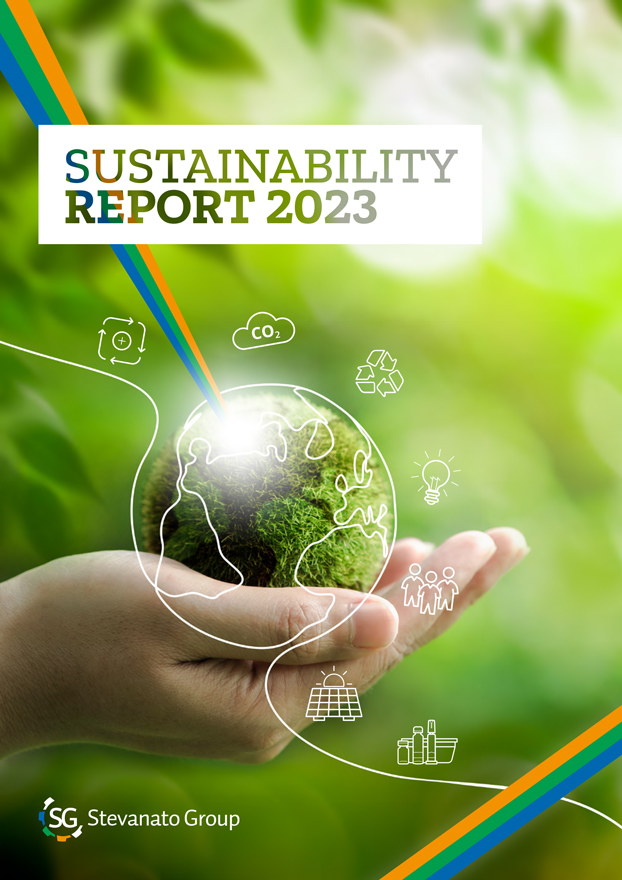
SUSTAINABILITY REPORT 2023
Exhibit 99.3

SUSTAINABILITY REPORT 2023
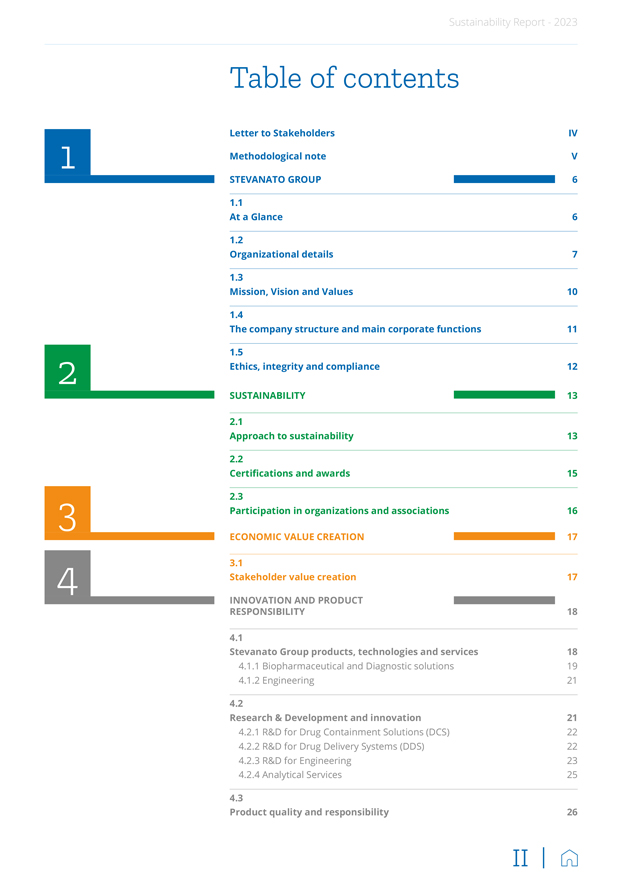
Table of contents Letter to Stakeholders IV 1 Methodological note V STEVANATO GROUP 6 1.1 At a Glance 6 1.2 Organizational details 7 1.3 Mission, Vision and Values 10 1.4 The company structure and main corporate functions 11 1.5 2 Ethics, integrity and compliance 12 SUSTAINABILITY 13 2.1 Approach to sustainability 13 2.2 Certifications and awards 15 2.3 3 Participation in organizations and associations 16 ECONOMIC VALUE CREATION 17 3.1 4 Stakeholder value creation 17 INNOVATION AND PRODUCT RESPONSIBILITY 18 4.1 Stevanato Group products, technologies and services 18 4.1.1 Biopharmaceutical and Diagnostic solutions 19 4.1.2 Engineering 21 4.2 Research & Development and innovation 21 4.2.1 R&D for Drug Containment Solutions (DCS) 22 4.2.2 R&D for Drug Delivery Systems (DDS) 22 4.2.3 R&D for Engineering 23 4.2.4 Analytical Services 25 4.3 Product quality and responsibility 26 II |
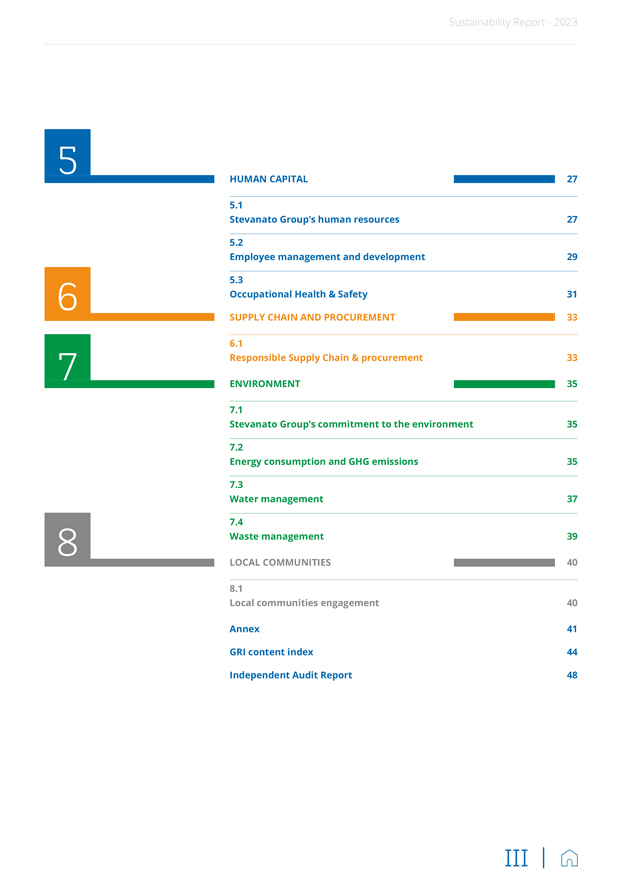
5 HUMAN CAPITAL 27 5.1 Stevanato Group’s human resources 27 5.2 Employee management and development 29 5.3 6 Occupational Health & Safety 31 SUPPLY CHAIN AND PROCUREMENT 33 6.1 7 Responsible Supply Chain & procurement 33 ENVIRONMENT 35 7.1 Stevanato Group’s commitment to the environment 35 7.2 Energy consumption and GHG emissions 35 7.3 Water management 37 7.4 8 Waste management 39 LOCAL COMMUNITIES 40 8.1 Local communities engagement 40 Annex 41 GRI content index 44 Independent Audit Report 48 III |

Letter to Stakeholders At Stevanato Group, we are part of over a 70-year history delivering exceptional performance to meet market and customer needs, thanks to our unique value proposition of integrating our core competencies across our business lines. The passion and commitment of all of us led our Group to become a leading provider of mission-critical containment, delivery, and diagnostic solutions for the pharmaceutical, biotechnology, and life sciences industries. The delivery of innovation and value has always characterized our Group, since its establishment and we embed science and technology in what we do every day to bring life-changing medicines to patients. Our goal is to be the global partner of choice to biopharma customers for the full spectrum of end-to-end solutions, from drug development through life-cycle management. Our commitment is to cooperate deeply with our partners all over the world, providing our extensive know-how, resources and enthusiasm to achieve the most successful result possibile for the customer in everything we do. We want to create a reliable ecosystem to empower our customers and their ability to produce safe, easy-to-use and cost-effective treatments to improve patients’ lives. We strive to support our stakeholders and we are committed to embedding sustainability in our strategic plan, policies and practices. We’re committed to a more sustainable and equitable future for our employees, customers, and communities which we serve. To accomplish this, we’ve developed a sustainability strategy structured in three pillars: • Sustainable processes and products, to minimize any potential negative environmental impact; • Sustainable value chain, to collaborate with partners on improving societal and environmental impacts: • People and governance, to establish and maintain a sustainable and transparent corporate model. The main goal is to pursue a regenerative business innovation journey while asserting our position as an interdependent and responsible member of the community in line with the United Nations’ Sustainable Development Goals. Hence, we are pleased to share our third Sustainability Report on a voluntary basis. This report reaffirms our dedication to ethical and environmentally conscious business practices while summarizing some of the actions being undertaken to address current environmental, social, and economic challenges. In 2023, we stepped forward and progressed in our regenerative business innovation journey. In particular, with regard to environmental efforts, we advanced in developing our plan to reduce GHG emissions of our business in line with Science Based Targets and we have begun to execute this plan through efficiency-related initiatives and sourcing of renewables-based electricity. In addition, we improved our waste management practices with an increase in the amount of waste recovered and diverted from landfill. We aim to foster a culture that values Diversity, Equity & Inclusion with attitudes and behaviors which characterize us and the path we are undergoing. Thus, we confirmed our commitment for a diverse workplace with our Gender Balance program on females holding senior positions. Finally, with reference to the Governance area, we continue to strengthen our policies and procedures system. In 2023, we started activities to update our Whistleblowing system and procedure according to EU Directive 2019/1937 and we reinforced our disclosures on GRI Reporting and Rating & Indexes. This aim of these activities are to improve and to maintain a sustainable corporate model. With regard to Rating, we significantly improved our disclosure in Carbon Disclosure Project (CDP) with extension at Group level for wider transparency and, in addition, we achieved “Management level”, above the relevant benchmark. This is an achievement for the Group that values the work done and paves the way for future steps. We confirm our goal is to continue growing and supporting customers throughout our regenerative business innovation while making a positive impact everywhere we work and do business. We will continue to work to improve processes, to innovate on technologies, to eco-design products and packaging, while considering our Values and Guiding Principles as cornerstone of harmonious interactions at Stevanato Group and the roots of our leadership in excellence. Therefore, we keep on pursuing this important journey with confidence and determination towards an increasingly sustainable and responsible future. Franco Stevanato Franco Moro Executive Chairman Chief Executive Officer Stevanato Group S.p.A. Stevanato Group S.p.A. Via Molinella 17, 35017 Via Molinella 17, 35017 Piombino Dese · Padova · Italy Piombino Dese · Padova · Italy
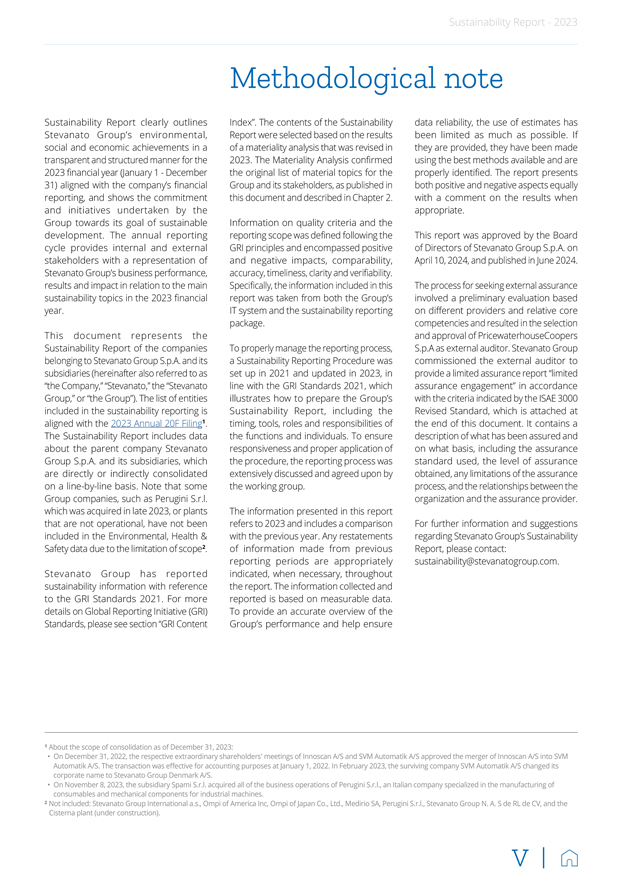
Methodological note Sustainability Report clearly outlines Stevanato Group’s environmental, social and economic achievements in a transparent and structured manner for the 2023 financial year (January 1—December 31) aligned with the company’s financial reporting, and shows the commitment and initiatives undertaken by the Group towards its goal of sustainable development. The annual reporting cycle provides internal and external stakeholders with a representation of Stevanato Group’s business performance, results and impact in relation to the main sustainability topics in the 2023 financial year. This document represents the Sustainability Report of the companies belonging to Stevanato Group S.p.A. and its subsidiaries (hereinafter also referred to as “the Company,” “Stevanato,” the “Stevanato Group,” or “the Group”). The list of entities included in the sustainability reporting is aligned with the 2023 Annual 20F Filing1. The Sustainability Report includes data about the parent company Stevanato Group S.p.A. and its subsidiaries, which are directly or indirectly consolidated on a line-by-line basis. Note that some Group companies, such as Perugini S.r.l. which was acquired in late 2023, or plants that are not operational, have not been included in the Environmental, Health & Safety data due to the limitation of scope2. Stevanato Group has reported sustainability information with reference to the GRI Standards 2021. For more details on Global Reporting Initiative (GRI) Standards, please see section “GRI Content Index”. The contents of the Sustainability Report were selected based on the results of a materiality analysis that was revised in 2023. The Materiality Analysis confirmed the original list of material topics for the Group and its stakeholders, as published in this document and described in Chapter 2. Information on quality criteria and the reporting scope was defined following the GRI principles and encompassed positive and negative impacts, comparability, accuracy, timeliness, clarity and verifiability. Specifically, the information included in this report was taken from both the Group’s IT system and the sustainability reporting package. To properly manage the reporting process, a Sustainability Reporting Procedure was set up in 2021 and updated in 2023, in line with the GRI Standards 2021, which illustrates how to prepare the Group’s Sustainability Report, including the timing, tools, roles and responsibilities of the functions and individuals. To ensure responsiveness and proper application of the procedure, the reporting process was extensively discussed and agreed upon by the working group. The information presented in this report refers to 2023 and includes a comparison with the previous year. Any restatements of information made from previous reporting periods are appropriately indicated, when necessary, throughout the report. The information collected and reported is based on measurable data. To provide an accurate overview of the Group’s performance and help ensure data reliability, the use of estimates has been limited as much as possible. If they are provided, they have been made using the best methods available and are properly identified. The report presents both positive and negative aspects equally with a comment on the results when appropriate. This report was approved by the Board of Directors of Stevanato Group S.p.A. on April 10, 2024, and published in June 2024. The process for seeking external assurance involved a preliminary evaluation based on different providers and relative core competencies and resulted in the selection and approval of PricewaterhouseCoopers S.p.A as external auditor. Stevanato Group commissioned the external auditor to provide a limited assurance report “limited assurance engagement” in accordance with the criteria indicated by the ISAE 3000 Revised Standard, which is attached at the end of this document. It contains a description of what has been assured and on what basis, including the assurance standard used, the level of assurance obtained, any limitations of the assurance process, and the relationships between the organization and the assurance provider. For further information and suggestions regarding Stevanato Group’s Sustainability Report, please contact: sustainability@stevanatogroup.com. ¹ About the scope of consolidation as of December 31, 2023: • On December 31, 2022, the respective extraordinary shareholders’ meetings of Innoscan A/S and SVM Automatik A/S approved the merger of Innoscan A/S into SVM Automatik A/S. The transaction was effective for accounting purposes at January 1, 2022. In February 2023, the surviving company SVM Automatik A/S changed its corporate name to Stevanato Group Denmark A/S. • On November 8, 2023, the subsidiary Spami S.r.l. acquired all of the business operations of Perugini S.r.l., an Italian company specialized in the manufacturing of consumables and mechanical components for industrial machines. ² Not included: Stevanato Group International a.s., Ompi of America Inc, Ompi of Japan Co., Ltd., Medirio SA, Perugini S.r.l.,Stevanato Group N. A. S de RL de CV, and the Cisterna plant (under construction). V |

Sustainability Report—2023 Stevanato 1 Group 1.1 At a Glance 468,432.2 GJ OF 9,691 TONS OF WASTE ELECTRICITY CONSUMPTION INCLUDING INCLUDING PRODUCT 12% FROM RENEWABLE SOURCES 88% OF RECOVERED WASTE & PROCESS ECODESIGN 7 DIFFERENT ISO CERTIFICATIONS OF SUSTAINABLE PRODUCTS ISCC+ CERTIFICATION CHAIN 55.5/100 OVERALL ECOVADIS SCORE OF RATED SUPPLIERS VALUE 5,626 EMPLOYEES 22.4% OF FEMALE IN THE WORLD DIRECTORS AND MANAGERS³ 193+ THOUSANDS OF TRAINING HOURS IN 2023 WITH AN INCREASE OF 25% IN COMPARISON TO PREVIOUS YEAR INITIATIVES TO PROMOTE HEALTH AND SAFETY AT A GLOBAL LEVEL ESG CODE OF ETHICS AND COMMITTEE AND ETHICAL CONDUCT-RELATED PEOPLE AT THE BOARD LEVEL POLICIES €1,1 Billion 16 WORLDWIDE TOTAL VALUE GENERATED IN 2023 PRODUCTION PLANTS 79% OF GENERATED VALUE APPROXIMATELY 70 COUNTRIES DISTRIBUTED SERVED OVER 70 YEARS OF HISTORY, GLOBAL PARTNER OF CHOICE TO BIOPHARMA CUSTOMERS Stevanato Group 6 |
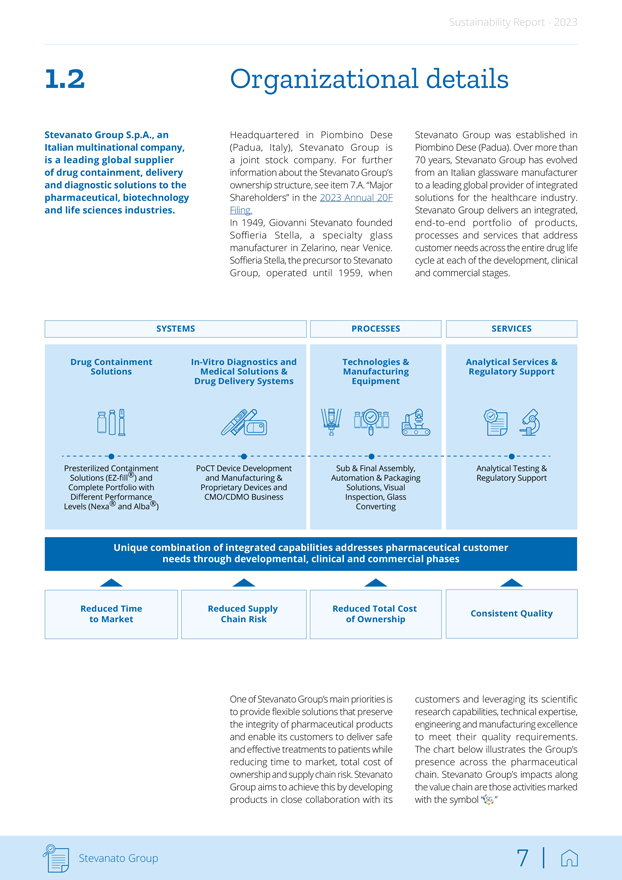
Sustainability Report—2023 1.2 Stevanato Group S.p.A., an Italian multinational company, is a leading global supplier of drug containment, delivery and diagnostic solutions to the pharmaceutical, biotechnology and life sciences industries. Organizational details Headquartered in Piombino Dese (Padua, Italy), Stevanato Group is a joint stock company. For further information about the Stevanato Group’s ownership structure, see item 7.A. “Major Shareholders” in the 2023 Annual 20F Filing. In 1949, Giovanni Stevanato founded Soffieria Stella, a specialty glass manufacturer in Zelarino, near Venice. Soffieria Stella, the precursor to Stevanato Group, operated until 1959, when Stevanato Group was established in Piombino Dese (Padua). Over more than 70 years, Stevanato Group has evolved from an Italian glassware manufacturer to a leading global provider of integrated solutions for the healthcare industry. Stevanato Group delivers an integrated, end-to-end portfolio of products, processes and services that address customer needs across the entire drug life cycle at each of the development, clinical and commercial stages. SYSTEMS PROCESSES SERVICES DrugSolutions Containment In-Medical Vitro Diagnostics Solutions and & Technologies Manufacturing & Analytical Regulatory Services Support & Drug Delivery Systems Equipment Presterilized Containment PoCT Device Development Sub & Final Assembly, Analytical Testing & Solutions (EZ-fill®) and and Manufacturing & Automation & Packaging Regulatory Support Complete Portfolio with Proprietary Devices and Solutions, Visual Diffrent Performance CMO/CDMO Business Inspection, Glass Levels (Nexa® and Alba®) Converting Unique combination of integrated capabilities addresses pharmaceutical customer needs through developmental, clinical and commercial phases Reduced Time Reduced Supply Reduced Total Cost Consistent Quality to Market Chain Risk of Ownership One of Stevanato Group’s main priorities is to provide flexible solutions that preserve the integrity of pharmaceutical products and enable its customers to deliver safe and effective treatments to patients while reducing time to market, total cost of ownership and supply chain risk. Stevanato Group aims to achieve this by developing products in close collaboration with its customers and leveraging its scientific research capabilities, technical expertise, engineering and manufacturing excellence to meet their quality requirements. The chart below illustrates the Group’s presence across the pharmaceutical chain. Stevanato Group’s impacts along the value chain are those activities marked with the symbol “ ” Stevanato Group 7 |

Sustainability Report—2023 STEVANATO GROUP’S ROLE ALONG THE PHARMA VALUE CHAIN DRUG SUBSTANCE DRUG PRODUCT API Drug Finished Manufacturing Formulation Product Device & Container Device & Container Drug Concept, Design & Testing Manufacturing Discovery Fill & Finish Automated Packaging Marketing & Line Machinery and Equipment Visual & Assembly Distribution Development and Manufacturing Inspection Stevanato Group divides its market into two categories: direct markets and end markets. Direct markets are comprised of products or product categories in which Stevanato directly participates, such as drug containment solutions. The Group’s end markets include broader sectors in which Stevanato sees demand for its products and services, such as vaccines and biologics. For further information about the Stevanato Group’s Value Chain, see item 4. “Information on the Company” and section b. “Business Overview” in the 2023 Annual 20F Filing. Stevanato Group has forged many business relationships from collaborations on the development of new technologies and products. For insights into the most relevant business relationships, please visit Press Releases—Stevanato Group. DIRECT MARKETS Business Segment Biopharmaceutical and Diagnostic Solutions Engineering Drug Drug In-Vitro Direct Market Containment Delivery Diagnostic Engineering Solutions Systems Solutions End Market Small Molecules Molecular Biologics Vaccines Insulin Other & Generics Diagnostics Stevanato Group operates in the following segments: Biopharmaceutical and Diagnostic Solutions Segment Drug Solutions Containment Delivery Drug Systems Solutions IVD Analytical Services Platforms for Platforms for Auto- Pen Medical IVD Syringes Vials Injectors Injectors Solutions Consumables • Primary Container Compatibility and Functionality with Drug Product • Container Closure Integrity • Medical Devices/Combination Products Platforms for On-body CMO/CMDO Point-of-Care • Developmental (non-GMP) Fill & Cartridges Delivery Capabilities Devices Finish services Systems • Consultancy (Regulatory, Compliance Support, Test Method Development and Transfer) Offering Proprietary “High-Value Solutions” Across Business Lines Stevanato Group 8 |
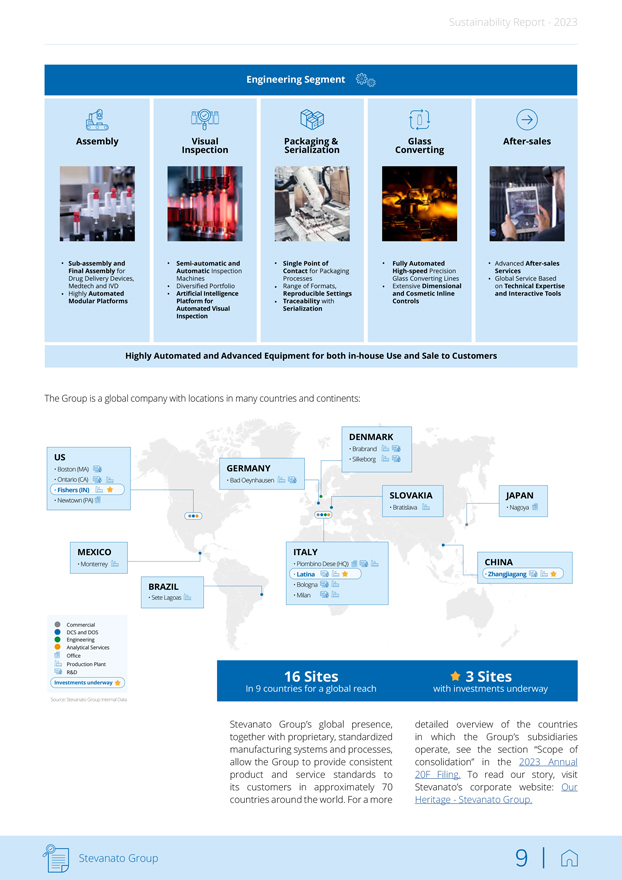
Sustainability Report—2023 Engineering Segment Assembly Visual Packaging & Glass After-sales Inspection Serialization Converting • Sub-assembly and • Semi-automatic and • Single Point of • Fully Automated • Advanced After-sales Final Assembly for Automatic Inspection Contact for Packaging High-speed Precision Services Drug Delivery Devices, Machines Processes Glass Converting Lines • Global Service Based Medtech and IVD • Diversified Portfolio • Range of Formats, • Extensive Dimensional on Technical Expertise • Highly Automated • Artificial Intelligence Reproducible Settings and Cosmetic Inline and Interactive Tools Modular Platforms Platform for • Traceability with Controls Automated Visual Serialization Inspection Highly Automated and Advanced Equipment for both in-house Use and Sale to Customers The Group is a global company with locations in many countries and continents: US • Boston (MA) • Ontario (CA) • Fishers (IN) • Newtown (PA) MEXICO • Monterrey BRAZIL • Sete Lagoas DENMARK • Brabrand • Silkeborg GERMANY • Bad Oeynhausen SLOVAKIA JAPAN • Bratislava • Nagoya ITALY • Piombino Dese (HQ) CHINA • Latina • Zhangjiagang • Bologna • Milan Commercial DCS and DOS Engineering Analytical Services Office Production Plant R&D 16 Sites 3 Sites Investments underway In 9 countries for a global reach with investments underway Source: Stevanato Group Internal Data Stevanato Group’s global presence, detailed overview of the countries together with proprietary, standardized in which the Group’s subsidiaries manufacturing systems and processes, operate, see the section “Scope of allow the Group to provide consistent consolidation” in the 2023 Annual product and service standards to 20F Filing. To read our story, visit its customers in approximately 70 Stevanato’s corporate website: Our countries around the world. For a more Heritage—Stevanato Group. Stevanato Group 9 |
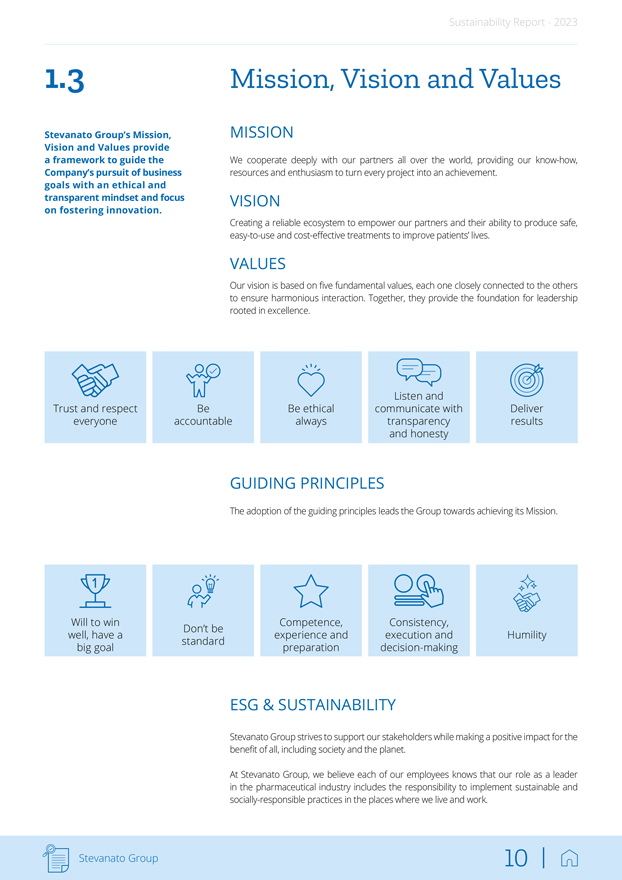
Sustainability Report—2023 Mission, Vision and Values 1.3 Stevanato Group’s Mission, Vision and Values provide a framework to guide the Company’s pursuit of business goals with an ethical and transparent mindset and focus on fostering innovation. MISSION We cooperate deeply with our partners all over the world, providing our know-how, resources and enthusiasm to turn every project into an achievement. VISION Creating a reliable ecosystem to empower our partners and their ability to produce safe, easy-to-use and cost-effective treatments to improve patients’ lives. VALUES Our vision is based on five fundamental values, each one closely connected to the others to ensure harmonious interaction. Together, they provide the foundation for leadership rooted in excellence. Listen and Trust and respect Be Be ethical communicate with Deliver everyone accountable always transparency results and honesty GUIDING PRINCIPLES The adoption of the guiding principles leads the Group towards achieving its Mission. Will to win Competence, Consistency, Don’t be well, have a experience and execution and Humility standard big goal preparation decision-making ESG & SUSTAINABILITY Stevanato Group strives to support our stakeholders while making a positive impact for the benefit of all, including society and the planet. At Stevanato Group, we believe each of our employees knows that our role as a leader in the pharmaceutical industry includes the responsibility to implement sustainable and socially-responsible practices in the places where we live and work. Stevanato Group 10 |
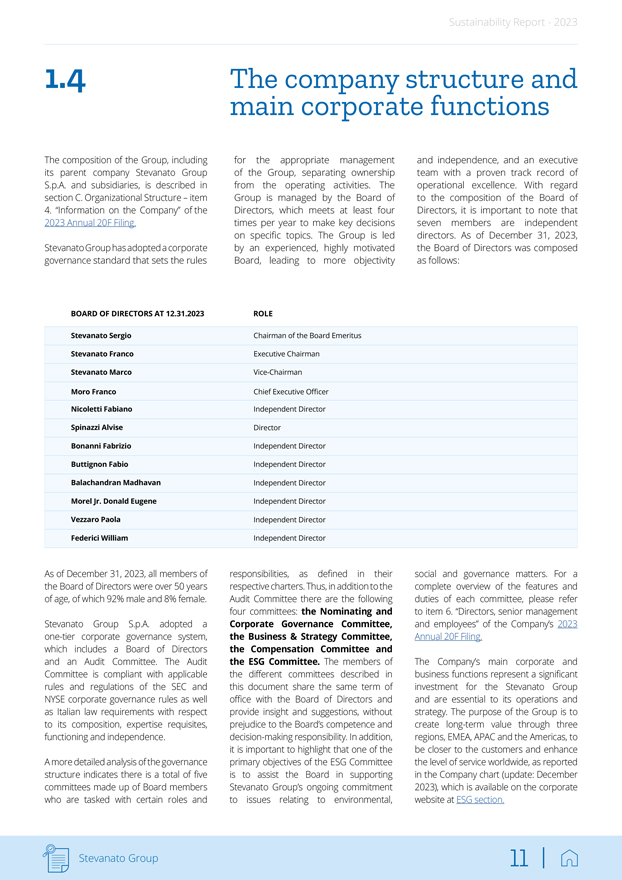
1.4 Sustainability Report—2023 The company structure and main corporate functions The composition of the Group, including its parent company Stevanato Group S.p.A. and subsidiaries, is described in section C. Organizational Structure – item 4. “Information on the Company” of the 2023 Annual 20F Filing. Stevanato Group has adopted a corporate governance standard that sets the rules BOARD OF DIRECTORS AT 12.31.2023 for the appropriate management of the Group, separating ownership from the operating activities. The Group is managed by the Board of Directors, which meets at least four times per year to make key decisions on specific topics. The Group is led by an experienced, highly motivated Board, leading to more objectivity ROLE and independence, and an executive team with a proven track record of operational excellence. With regard to the composition of the Board of Directors, it is important to note that seven members are independent directors. As of December 31, 2023, the Board of Directors was composed as follows: Stevanato Sergio Chairman of the Board Emeritus Stevanato Franco Executive Chairman Stevanato Marco Vice-Chairman Moro Franco Chief Executive Officer Nicoletti Fabiano Independent Director Spinazzi Alvise Director Bonanni Fabrizio Independent Director Buttignon Fabio Independent Director Balachandran Madhavan Independent Director Morel Jr. Donald Eugene Independent Director Vezzaro Paola Independent Director Federici William Independent Director As of December 31, 2023, all members of the Board of Directors were over 50 years of age, of which 92% male and 8% female. Stevanato Group S.p.A. adopted a one-tier corporate governance system, which includes a Board of Directors and an Audit Committee. The Audit Committee is compliant with applicable rules and regulations of the SEC and NYSE corporate governance rules as well as Italian law requirements with respect to its composition, expertise requisites, functioning and independence. A more detailed analysis of the governance structure indicates there is a total of five committees made up of Board members who are tasked with certain roles and responsibilities, as defined in their respective charters. Thus, in addition to the Audit Committee there are the following four committees: the Nominating and Corporate Governance Committee, the Business & Strategy Committee, the Compensation Committee and the ESG Committee. The members of the different committees described in this document share the same term of office with the Board of Directors and provide insight and suggestions, without prejudice to the Board’s competence and decision-making responsibility. In addition, it is important to highlight that one of the primary objectives of the ESG Committee is to assist the Board in supporting Stevanato Group’s ongoing commitment to issues relating to environmental, social and governance matters. For a complete overview of the features and duties of each committee, please refer to item 6. “Directors, senior management and employees” of the Company’s 2023 Annual 20F Filing. The Company’s main corporate and business functions represent a significant investment for the Stevanato Group and are essential to its operations and strategy. The purpose of the Group is to create long-term value through three regions, EMEA, APAC and the Americas, to be closer to the customers and enhance the level of service worldwide, as reported in the Company chart (update: December 2023), which is available on the corporate website at ESG section. Stevanato Group 11 |
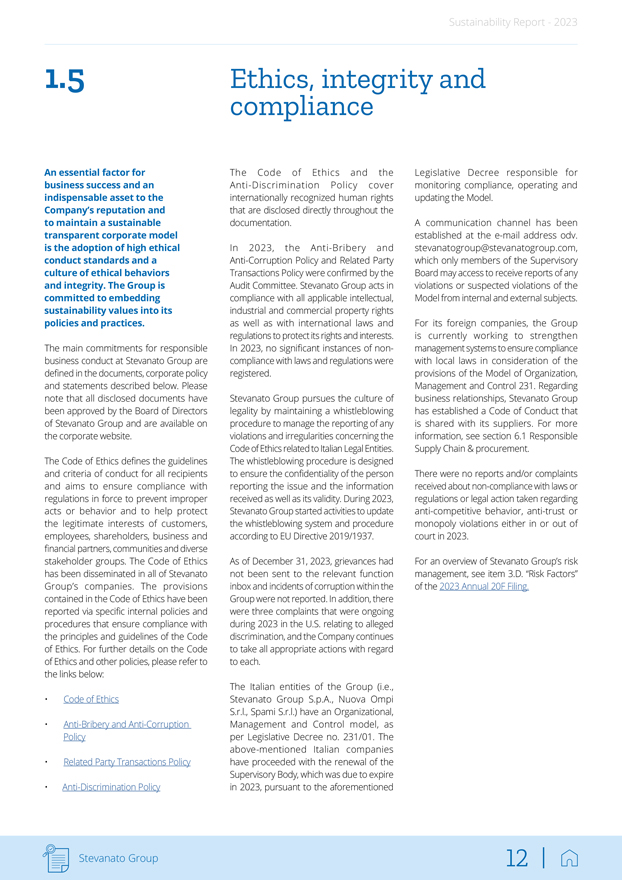
Sustainability Report—2023 1.5 An essential factor for business success and an indispensable asset to the Company’s reputation and to maintain a sustainable transparent corporate model is the adoption of high ethical conduct standards and a culture of ethical behaviors and integrity. The Group is committed to embedding sustainability values into its policies and practices. The main commitments for responsible business conduct at Stevanato Group are defined in the documents, corporate policy and statements described below. Please note that all disclosed documents have been approved by the Board of Directors of Stevanato Group and are available on the corporate website. The Code of Ethics defines the guidelines and criteria of conduct for all recipients and aims to ensure compliance with regulations in force to prevent improper acts or behavior and to help protect the legitimate interests of customers, employees, shareholders, business and financial partners, communities and diverse stakeholder groups. The Code of Ethics has been disseminated in all of Stevanato Group’s companies. The provisions contained in the Code of Ethics have been reported via specific internal policies and procedures that ensure compliance with the principles and guidelines of the Code of Ethics. For further details on the Code of Ethics and other policies, please refer to the links below: • Code of Ethics • Anti-Bribery and Anti-Corruption Policy • Related Party Transactions Policy • Anti-Discrimination Policy Ethics, integrity and compliance The Code of Ethics and the Anti-Discrimination Policy cover internationally recognized human rights that are disclosed directly throughout the documentation. In 2023, the Anti-Bribery and Anti-Corruption Policy and Related Party Transactions Policy were confirmed by the Audit Committee. Stevanato Group acts in compliance with all applicable intellectual, industrial and commercial property rights as well as with international laws and regulations to protect its rights and interests. In 2023, no significant instances of non-compliance with laws and regulations were registered. Stevanato Group pursues the culture of legality by maintaining a whistleblowing procedure to manage the reporting of any violations and irregularities concerning the Code of Ethics related to Italian Legal Entities. The whistleblowing procedure is designed to ensure the confidentiality of the person reporting the issue and the information received as well as its validity. During 2023, Stevanato Group started activities to update the whistleblowing system and procedure according to EU Directive 2019/1937. As of December 31, 2023, grievances had not been sent to the relevant function inbox and incidents of corruption within the Group were not reported. In addition, there were three complaints that were ongoing during 2023 in the U.S. relating to alleged discrimination, and the Company continues to take all appropriate actions with regard to each. The Italian entities of the Group (i.e., Stevanato Group S.p.A., Nuova Ompi S.r.l., Spami S.r.l.) have an Organizational, Management and Control model, as per Legislative Decree no. 231/01. The above-mentioned Italian companies have proceeded with the renewal of the Supervisory Body, which was due to expire in 2023, pursuant to the aforementioned Legislative Decree responsible for monitoring compliance, operating and updating the Model. A communication channel has been established at the e-mail address odv. stevanatogroup@stevanatogroup.com, which only members of the Supervisory Board may access to receive reports of any violations or suspected violations of the Model from internal and external subjects. For its foreign companies, the Group is currently working to strengthen management systems to ensure compliance with local laws in consideration of the provisions of the Model of Organization, Management and Control 231. Regarding business relationships, Stevanato Group has established a Code of Conduct that is shared with its suppliers. For more information, see section 6.1 Responsible Supply Chain & procurement. There were no reports and/or complaints received about non-compliance with laws or regulations or legal action taken regarding anti-competitive behavior, anti-trust or monopoly violations either in or out of court in 2023. For an overview of Stevanato Group’s risk management, see item 3.D. “Risk Factors” of the 2023 Annual 20F Filing. Stevanato Group 12 |
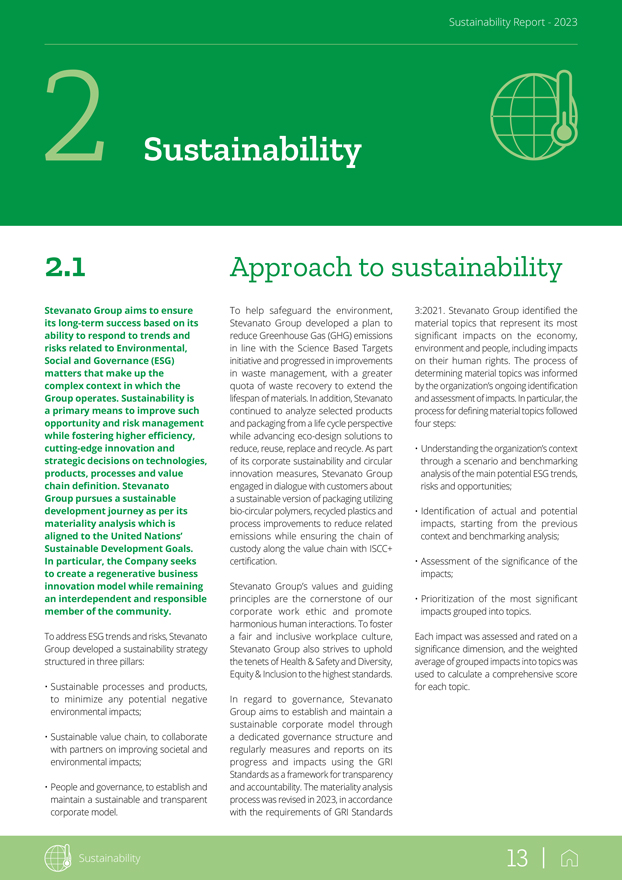
Sustainability Report—2023 2Sustainability 2.1 Stevanato Group aims to ensure its long-term success based on its ability to respond to trends and risks related to Environmental, Social and Governance (ESG) matters that make up the complex context in which the Group operates. Sustainability is a primary means to improve such opportunity and risk management while fostering higher efficiency, cutting-edge innovation and strategic decisions on technologies, products, processes and value chain definition. Stevanato Group pursues a sustainable development journey as per its materiality analysis which is aligned to the United Nations’ Sustainable Development Goals. In particular, the Company seeks to create a regenerative business innovation model while remaining an interdependent and responsible member of the community. To address ESG trends and risks, Stevanato Group developed a sustainability strategy structured in three pillars: • Sustainable processes and products, to minimize any potential negative environmental impacts; • Sustainable value chain, to collaborate with partners on improving societal and environmental impacts; • People and governance, to establish and maintain a sustainable and transparent corporate model. Approach to sustainability To help safeguard the environment, Stevanato Group developed a plan to reduce Greenhouse Gas (GHG) emissions in line with the Science Based Targets initiative and progressed in improvements in waste management, with a greater quota of waste recovery to extend the lifespan of materials. In addition, Stevanato continued to analyze selected products and packaging from a life cycle perspective while advancing eco-design solutions to reduce, reuse, replace and recycle. As part of its corporate sustainability and circular innovation measures, Stevanato Group engaged in dialogue with customers about a sustainable version of packaging utilizing bio-circular polymers, recycled plastics and process improvements to reduce related emissions while ensuring the chain of custody along the value chain with ISCC+ certification. Stevanato Group’s values and guiding principles are the cornerstone of our corporate work ethic and promote harmonious human interactions. To foster a fair and inclusive workplace culture, Stevanato Group also strives to uphold the tenets of Health & Safety and Diversity, Equity & Inclusion to the highest standards. In regard to governance, Stevanato Group aims to establish and maintain a sustainable corporate model through a dedicated governance structure and regularly measures and reports on its progress and impacts using the GRI Standards as a framework for transparency and accountability. The materiality analysis process was revised in 2023, in accordance with the requirements of GRI Standards 3:2021. Stevanato Group identified the material topics that represent its most significant impacts on the economy, environment and people, including impacts on their human rights. The process of determining material topics was informed by the organization’s ongoing identification and assessment of impacts. In particular, the process for defining material topics followed four steps: • Understanding the organization’s context through a scenario and benchmarking analysis of the main potential ESG trends, risks and opportunities; • Identification of actual and potential impacts, starting from the previous context and benchmarking analysis; • Assessment of the significance of the impacts; • Prioritization of the most significant impacts grouped into topics. Each impact was assessed and rated on a significance dimension, and the weighted average of grouped impacts into topics was used to calculate a comprehensive score for each topic. Sustainability 13 |
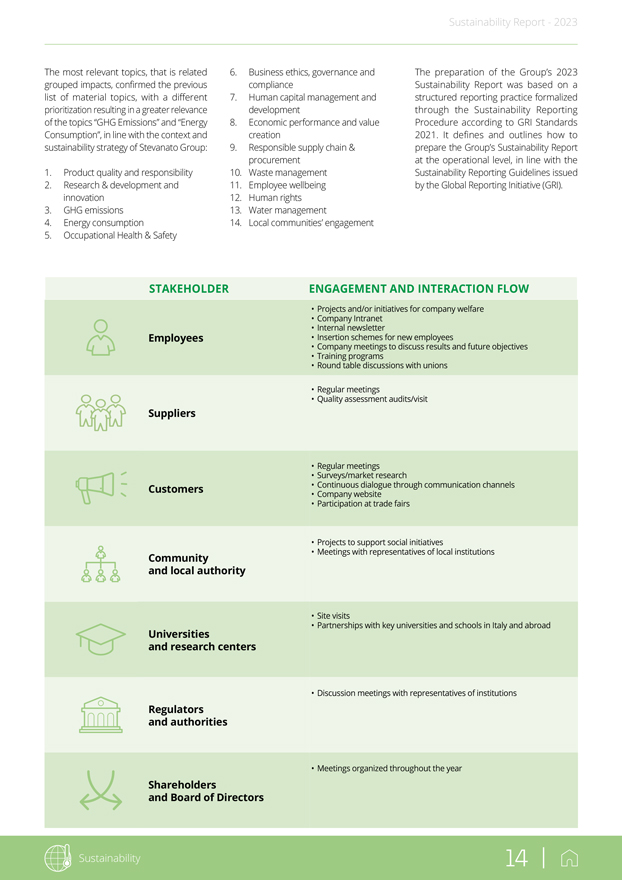
Sustainability Report—2023 The most relevant topics, that is related grouped impacts, confirmed the previous list of material topics, with a different prioritization resulting in a greater relevance of the topics “GHG Emissions” and “Energy Consumption”, in line with the context and sustainability strategy of Stevanato Group: 1. Product quality and responsibility 2. Research & development and innovation 3. GHG emissions 4. Energy consumption 5. Occupational Health & Safety 6. Business ethics, governance and compliance 7. Human capital management and development 8. Economic performance and value creation 9. Responsible supply chain & procurement 10. Waste management 11. Employee wellbeing 12. Human rights 13. Water management 14. Local communities’ engagement The preparation of the Group’s 2023 Sustainability Report was based on a structured reporting practice formalized through the Sustainability Reporting Procedure according to GRI Standards 2021. It defines and outlines how to prepare the Group’s Sustainability Report at the operational level, in line with the Sustainability Reporting Guidelines issued by the Global Reporting Initiative (GRI). STAKEHOLDER Employees Suppliers Customers Community and local authority Universities and research centers Regulators and authorities Shareholders and Board of Directors Sustainability ENGAGEMENT AND INTERACTION FLOW • Projects and/or initiatives for company welfare • Company Intranet • Internal newsletter • Insertion schemes for new employees • Company meetings to discuss results and future objectives • Training programs • Round table discussions with unions • Regular meetings • Quality assessment audits/visit • Regular meetings • Surveys/market research • Continuous dialogue through communication channels • Company website • Participation at trade fairs • Projects to support social initiatives • Meetings with representatives of local institutions • Site visits • Partnerships with key universities and schools in Italy and abroad • Discussion meetings with representatives of institutions • Meetings organized throughout the year 14 |

Sustainability Report—2023 The procedure included the timing, tools, roles and responsibilities of the functions and individuals’ part of the working group (about one hundred individuals across the Group) and ensured the engagement and proper application of all procedures. Finally, it is important to note that the process required correct and compliant GRI Key Performance Indicators (KPIs) associated with the involved functions and was coordinated by the Process Owner, as per assignment by the Board of Directors. The Group has adopted flexible and diversified practices to share present and future Group development strategies with its main stakeholders, which are listed above. The main stakeholders have been identified based on an industry benchmark. Stevanato Group adopts practices that encourage dialogue and involvement with all stakeholder categories. Engagement is considered an essential element of the Group’s sustainability strategy and is directly correlated with the Group’s medium- and long-term success. The main channels of dialogue and interaction are summarized above. The methods and frequency of stakeholder involvement vary according to the issues and opportunities subject to discussion during the year. 2.2 Certifications and awards Certification Description Legal Entity (Country)³ ISO 15378 Primary packaging material for medicine • Nuova Ompi (IT-PD) products—specific requirements for the • Nuova Ompi (IT-LT) application of ISO 9001:2015 with reference to Good Manufacturing Practice (GMP) • Medical Glass (SK) • Ompi North America (MX) • Ompi of China (CN) • Ompi do Brasil (BR) • Balda Medical (DE) • Ompi of America (U.S.) ISO 13485 Medical devices—Quality Management • Nuova Ompi (IT-PD) Systems • Balda Medical (DE) • Balda C. Brewer (CA-U.S.) • EMEA TEC (IT) • U.S. TEC (U.S.) • Ompi of America (U.S.) ISO 9001 Quality Management Systems • Nuova Ompi (IT-PD) • Nuova Ompi (IT-LT) • Medical Glass (SK) • Ompi North America (MX) • Ompi of China (CN) • Ompi do Brasil (BR) • Balda Medical (DE) • Balda C. Brewer (CA-U.S.) • Spami (IT) • EMEA TEC (IT) • U.S. TEC (U.S.) • Ompi of America (U.S.) • SG Denmark (DK) ISO 45001 Occupational Health and Safety • Nuova Ompi (IT-PD) management system • Nuova Ompi (IT-LT) • Medical Glass (SK) • Ompi North America (MX) • Ompi of China (CN) • Ompi do Brasil (BR) • Balda Medical (DE) • Ompi of America (U.S.) Sustainability 15 |
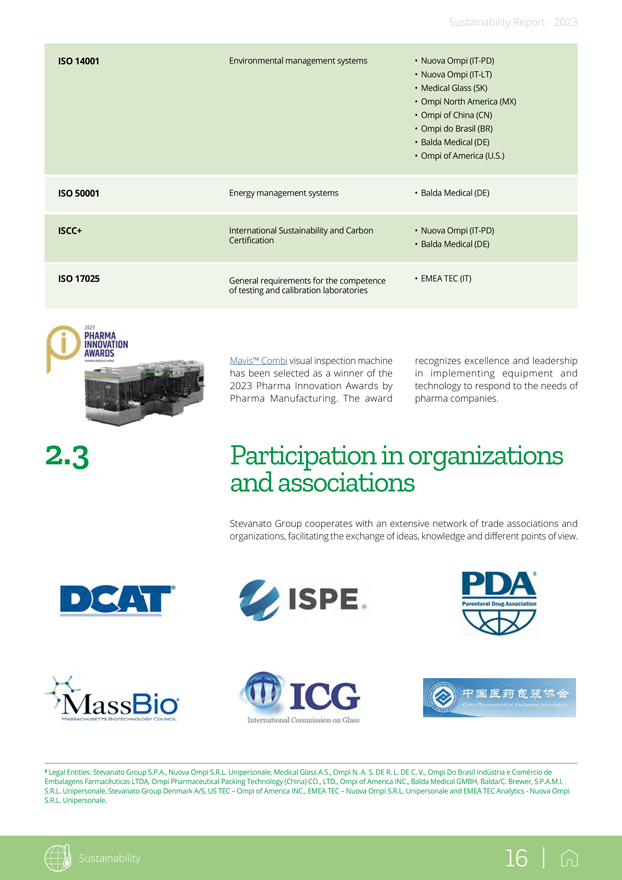
Sustainability Report—2023 ISO 14001 Environmental management systems • Nuova Ompi (IT-PD) • Nuova Ompi (IT-LT) • Medical Glass (SK) • Ompi North America (MX) • Ompi of China (CN) • Ompi do Brasil (BR) • Balda Medical (DE) • Ompi of America (U.S.) ISO 50001 Energy management systems • Balda Medical (DE) ISCC+ International Sustainability and Carbon • Nuova Ompi (IT-PD) Certification • Balda Medical (DE) ISO 17025 General requirements for the competence • EMEA TEC (IT) of testing and calibration laboratories Mavis™ Combi visual inspection machine recognizes excellence and leadership has been selected as a winner of the in implementing equipment and 2023 Pharma Innovation Awards by technology to respond to the needs of Pharma Manufacturing. The award pharma companies. 2.3 Participation in organizations and associations Stevanato Group cooperates with an extensive network of trade associations and organizations, facilitating the exchange of ideas, knowledge and different points of view. ³ Legal Entities: Stevanato Group S.P.A., Nuova Ompi S.R.L. Unipersonale, Medical Glass A.S., Ompi N. A. S. DE R. L. DE C. V., Ompi Do Brasil Indústria e Comércio de Embalagens Farmacêuticas LTDA, Ompi Pharmaceutical Packing Technology (China) CO., LTD., Ompi of America INC., Balda Medical GMBH, Balda/C. Brewer, S.P.A.M.I. S.R.L. Unipersonale, Stevanato Group Denmark A/S, US TEC – Ompi of America INC., EMEA TEC – Nuova Ompi S.R.L. Unipersonale and EMEA TEC Analytics—Nuova Ompi S.R.L. Unipersonale. Sustainability 16 |
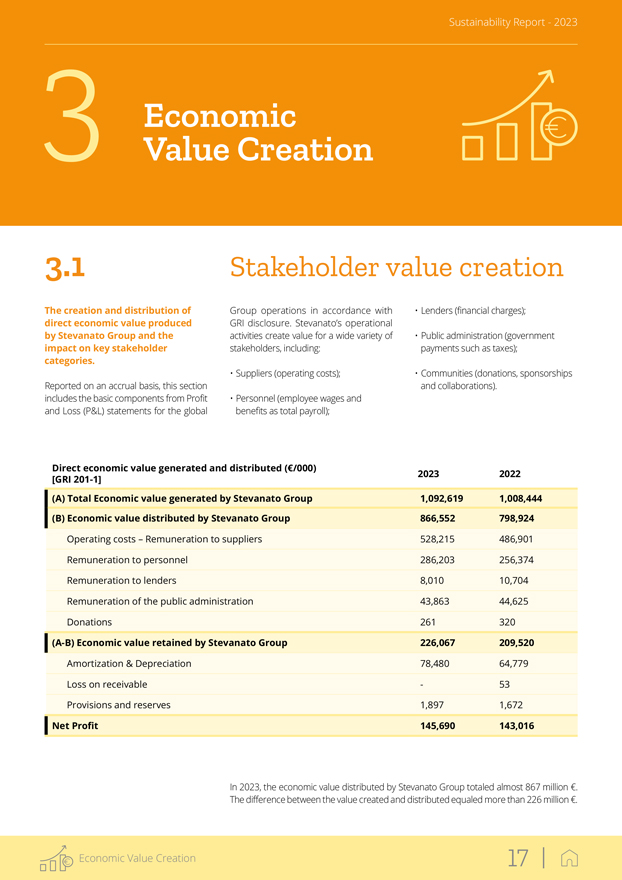
Sustainability Report—2023 Economic 3 Value Creation 3.1 The creation and distribution of direct economic value produced by Stevanato Group and the impact on key stakeholder categories. Reported on an accrual basis, this section includes the basic components from Profit and Loss (P&L) statements for the global Stakeholder value creation Group operations in accordance with GRI disclosure. Stevanato’s operational activities create value for a wide variety of stakeholders, including: • Suppliers (operating costs); • Personnel (employee wages and benefits as total payroll); • Lenders (financial charges); • Public administration (government payments such as taxes); • Communities (donations, sponsorships and collaborations). Direct economic value generated and distributed (€/000) 2023 2022 [GRI 201-1] (A) Total Economic value generated by Stevanato Group 1,092,619 1,008,444 (B) Economic value distributed by Stevanato Group 866,552 798,924 Operating costs – Remuneration to suppliers 528,215 486,901 Remuneration to personnel 286,203 256,374 Remuneration to lenders 8,010 10,704 Remuneration of the public administration 43,863 44,625 Donations 261 320 (A-B) Economic value retained by Stevanato Group 226,067 209,520 Amortization & Depreciation 78,480 64,779 Loss on receivable—53 Provisions and reserves 1,897 1,672 Net Profit 145,690 143,016 In 2023, the economic value distributed by Stevanato Group totaled almost 867 million €. The difference between the value created and distributed equaled more than 226 million €. Economic Value Creation 17 |
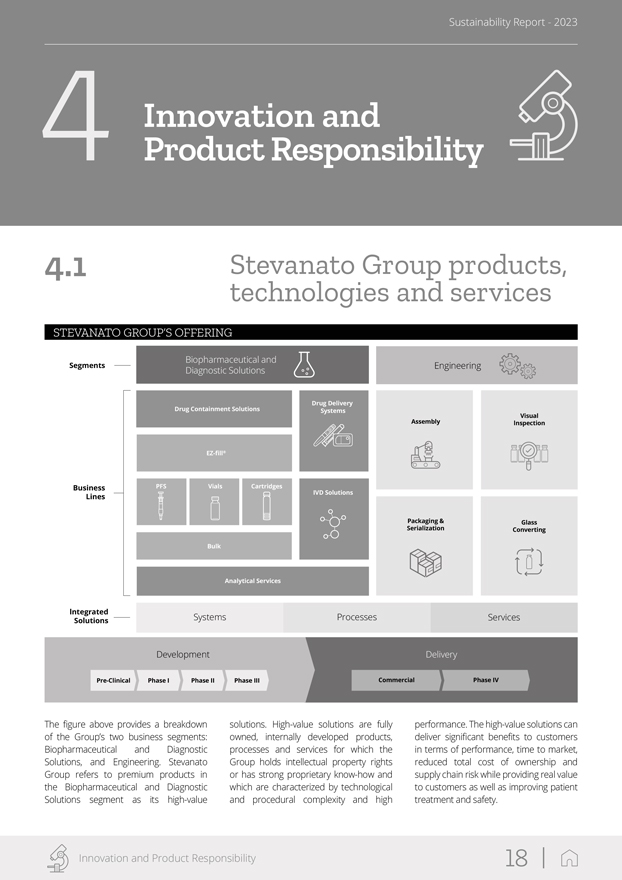
Sustainability Report—2023 Innovation and 4Product Responsibility 4.1 Stevanato Group products, technologies and services STEVANATO GROUP’S OFFERING Biopharmaceutical and Segments Engineering Diagnostic Solutions Drug Delivery Drug Containment Solutions Systems Visual Assembly lnspection EZ-fill® Business PFS Vials Cartridges IVD Solutions Lines Packaging & Glass Serialization Converting Bulk Analytical Services lntegrated Solutions Systems Processes Services Development Delivery Pre-Clinical Phase I Phase II Phase III Commercial Phase IV The figure above provides a breakdown of the Group’s two business segments: Biopharmaceutical and Diagnostic Solutions, and Engineering. Stevanato Group refers to premium products in the Biopharmaceutical and Diagnostic Solutions segment as its high-value solutions. High-value solutions are fully owned, internally developed products, processes and services for which the Group holds intellectual property rights or has strong proprietary know-how and which are characterized by technological and procedural complexity and high performance. The high-value solutions can deliver significant benefits to customers in terms of performance, time to market, reduced total cost of ownership and supply chain risk while providing real value to customers as well as improving patient treatment and safety. Innovation and Product Responsibility 18 |
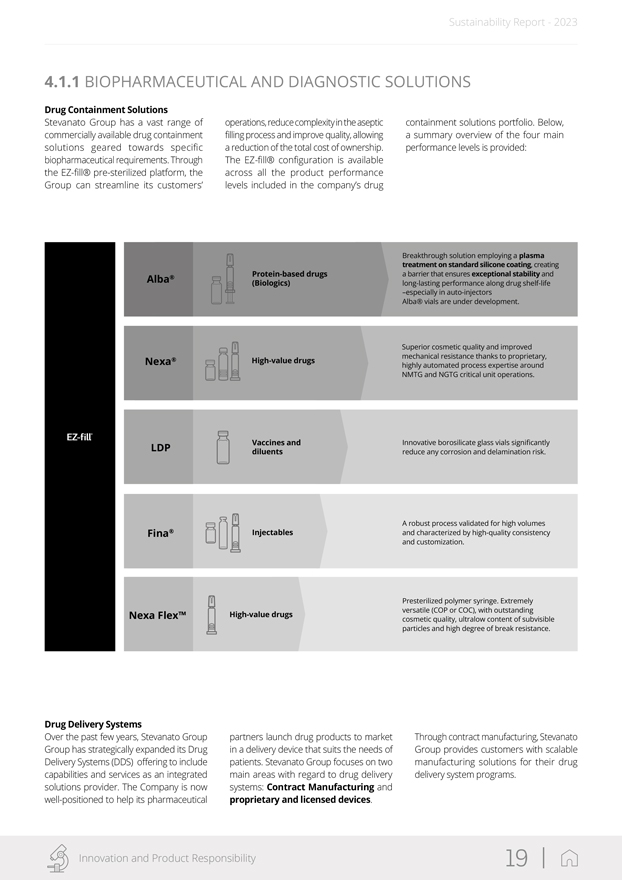
Sustainability Report—2023 4.1.1 BIOPHARMACEUTICAL AND DIAGNOSTIC SOLUTIONS Drug Containment Solutions Stevanato Group has a vast range of commercially available drug containment solutions geared towards specific biopharmaceutical requirements. Through the EZ-fill® pre-sterilized platform, the Group can streamline its customers’ Alba® Nexa® LDP Fina® Nexa Flex™ Drug Delivery Systems Over the past few years, Stevanato Group Group has strategically expanded its Drug Delivery Systems (DDS) offering to include capabilities and services as an integrated solutions provider. The Company is now well-positioned to help its pharmaceutical operations, reduce complexity in the aseptic filling process and improve quality, allowing a reduction of the total cost of ownership. The EZ-fill® configuration is available across all the product performance levels included in the company’s drug Protein-based drugs (Biologics) High-value drugs Vaccines and diluents Injectables High-value drugs partners launch drug products to market in a delivery device that suits the needs of patients. Stevanato Group focuses on two main areas with regard to drug delivery systems: Contract Manufacturing and proprietary and licensed devices. containment solutions portfolio. Below, a summary overview of the four main performance levels is provided: Breakthrough solution employing a plasma treatment on standard silicone coating, creating a barrier that ensures exceptional stability and long-lasting performance along drug shelf-life –especially in auto-injectors Alba® vials are under development. Superior cosmetic quality and improved mechanical resistance thanks to proprietary, highly automated process expertise around NMTG and NGTG critical unit operations. Innovative borosilicate glass vials significantly reduce any corrosion and delamination risk. A robust process validated for high volumes and characterized by high-quality consistency and customization. Presterilized polymer syringe. Extremely versatile (COP or COC), with outstanding cosmetic quality, ultralow content of subvisible particles and high degree of break resistance. Through contract manufacturing, Stevanato Group provides customers with scalable manufacturing solutions for their drug delivery system programs. Innovation and Product Responsibility 19 |

Sustainability Report—2023 Customers can rely on: A flexible and versatile Contract Development & Manufacturing Orgazination (CDMO) or Contract Manufacturing Organization (CMO) offering , covering different f stages of device development up to the final product; High-quality production standards, thanks to an ISO 13485 certified Quality Management System and FDA-inspected facilities, ensuring products are compliant and reliable; A worldwide presence, with manufacturing operations in Europe and the U.S. and a global purchasing network, fostering efficiency and accessibility through shorter supply chains; Ongoing exploration of sustainable materials and dedicated efforts toward more sustainable manufacturing practices, aligning with Stevanato Group’s commitment to environmental responsibility. Proprietary and licensed devices include Pen injectors, Auto-injectors and On-body delivery systems. Pen injectors Auto-injectors On-body devices Alina® is a variable and Together with Owen Mumford, Vertiva™ is a semi-reusable fixed-dose disposable pen Stevanato Group is providing cartridge-based On-Body Delivery injector, based on Axis-D Aidaptus®, an intuitive System composed of two parts: technology, exclusively licensed disposable auto-injector solution a single-use injection unit and a from pen injector device expert that offers flexibility and multi-use, smart controlling unit. It Haselmeier. It is suitable for a speed-to-market for customers. is optimized for the administration broad range of therapeutic areas Aidaptus will be manufactured of complex drug regimens from including diabetes and obesity. by both Owen Mumford and mid-high volume cartridges. Stevanato Group. IVD Solutions Stevanato Group Technology Excellence devices, and components comprising As a one-stop solution provider and Centers focus on: combined products. manufacturer, the Group can cover all parts of the process, from product development • Investigating the physical-chemical Stevanato Group relies on a to delivery of the final product, packaged properties of primary packaging materials multi-disciplinary team of highly-skilled and sterilized as needed. Stevanato Group and components and studying the professionals including scientists, solutions focuses on point-of-care devices, interactions between drug containment engineers, pharmaceutical chemists and in-vitro diagnostic consumables and medical solutions and drugs. biotechnologists. Their knowledge and solutions. experience cover a range of specialized • Providing laboratory services for the areas including drug containment solutions Analytical services design and engineering characterization and drug delivery devices. As a branch of Research and Development, of pharmaceutical packaging, medical Innovation and Product Responsibility 20 |
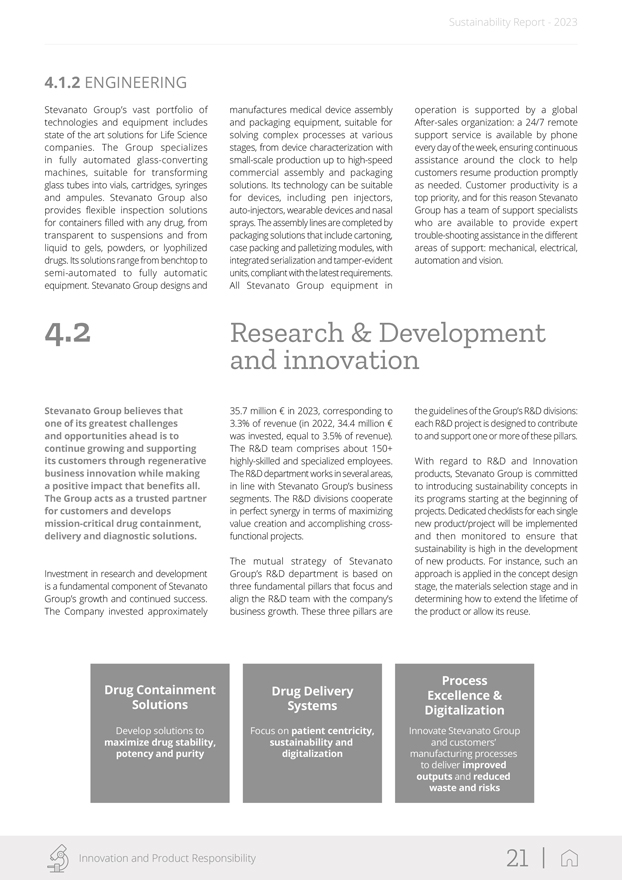
Sustainability Report—2023 4.1.2 ENGINEERING Stevanato Group’s vast portfolio of technologies and equipment includes state of the art solutions for Life Science companies. The Group specializes in fully automated glass-converting machines, suitable for transforming glass tubes into vials, cartridges, syringes and ampules. Stevanato Group also provides flexible inspection solutions for containers filled with any drug, from transparent to suspensions and from liquid to gels, powders, or lyophilized drugs. Its solutions range from benchtop to semi-automated to fully automatic equipment. Stevanato Group designs and manufactures medical device assembly and packaging equipment, suitable for solving complex processes at various stages, from device characterization with small-scale production up to high-speed commercial assembly and packaging solutions. Its technology can be suitable for devices, including pen injectors, auto-injectors, wearable devices and nasal sprays. The assembly lines are completed by packaging solutions that include cartoning, case packing and palletizing modules, with integrated serialization and tamper-evident units, compliant with the latest requirements. All Stevanato Group equipment in operation is supported by a global After-sales organization: a 24/7 remote support service is available by phone every day of the week, ensuring continuous assistance around the clock to help customers resume production promptly as needed. Customer productivity is a top priority, and for this reason Stevanato Group has a team of support specialists who are available to provide expert trouble-shooting assistance in the different areas of support: mechanical, electrical, automation and vision. 4.2 Stevanato Group believes that one of its greatest challenges and opportunities ahead is to continue growing and supporting its customers through regenerative business innovation while making a positive impact that benefits all. The Group acts as a trusted partner for customers and develops mission-critical drug containment, delivery and diagnostic solutions. Investment in research and development is a fundamental component of Stevanato Group’s growth and continued success. The Company invested approximately Research & Development and innovation 35.7 million € in 2023, corresponding to 3.3% of revenue (in 2022, 34.4 million € was invested, equal to 3.5% of revenue). The R&D team comprises about 150+ highly-skilled and specialized employees. The R&D department works in several areas, in line with Stevanato Group’s business segments. The R&D divisions cooperate in perfect synergy in terms of maximizing value creation and accomplishing cross-functional projects. The mutual strategy of Stevanato Group’s R&D department is based on three fundamental pillars that focus and align the R&D team with the company’s business growth. These three pillars are the guidelines of the Group’s R&D divisions: each R&D project is designed to contribute to and support one or more of these pillars. With regard to R&D and Innovation products, Stevanato Group is committed to introducing sustainability concepts in its programs starting at the beginning of projects. Dedicated checklists for each single new product/project will be implemented and then monitored to ensure that sustainability is high in the development of new products. For instance, such an approach is applied in the concept design stage, the materials selection stage and in determining how to extend the lifetime of the product or allow its reuse. Process Drug Containment Drug Delivery Excellence & Solutions Systems Digitalization Develop solutions to Focus on patient centricity, Innovate Stevanato Group maximize drug stability, sustainability and and customers’ potency and purity digitalization manufacturing processes to deliver improved outputs and reduced waste and risks Innovation and Product Responsibility 21 |

Sustainability Report—2023 4.2.1 R&D FOR DRUG CONTAINMENT SOLUTIONS (DCS) Stevanato Group’s DCS team is dedicated to designing and developing syringes, vials and cartridges that will provide higher drug compatibility (i.e., with lowest particle generation, reduced or even no extractable release and metal-free options). The team is also responsible for the identification and development of deep freeze/dead volume properties of Stevanato Group solutions for vaccine and gene therapies applications. To deliver superior process excellence & digitalization, the DCS team is working on different projects. Finally, the DCS team contributes to the development of Drug Delivery Systems designed around patient centricity, sustainability and digitalization and provides high quality primary packaging that is fully compatible with the devices under development. Stevanato Group has also introduced new sustainability practices as part of its corporate sustainability and circular innovation measures, with a particular emphasis on identifying alternative materials and processes that provide more sustainable sterilization techniques while maintaining the overall performance of materials post-sterilization cycle. As part of its corporate sustainability and circular innovation measures, Stevanato Group dialogued with customers on a sustainable version of secondary packaging for syringes, focusing on biopolymers and recycled plastic as well as packaging and process improvements to reduce related emissions and other sustainable measures. Stevanato Group is committed to reducing emissions and the use of fossil resources. The Ready-To-Use drug containers require single-use polymers for the pharmaceutical secondary packaging (Nest and Tub), to help ensure sterility and processability. Indeed, a bio-circular version of polystyrene and polypropylene that is used to produce secondary packaging of syringes was identified. The raw material for producing polymer is obtained from renewably sourced feedstocks derived solely from waste. This reduces the fossil resources consumption and emissions associated with the life cycle of the product while ensuring the same level of quality. Thanks to the ISCC+ certification, compliance with the mass balance approach can be maintained, which helps to support continued trust among customers and throughout the value chain. Replicating the same practice, since 2022, Stevanato Group’s EZ-fill Smart™ has offered the market a more environmentally friendly sterilization method compared to traditional ethylene oxide (EtO) sterilization, which can result in improved safety. It is intended to improve sustainability and increase packaging efficiency using biopolymers and recycled plastic. In 2023, Stevanato Group concluded a Life Cycle Assessment (LCA) of selected products. This rigorous process plays a pivotal role in making informed, data-driven decisions aimed at reducing the environmental impact of products. By pinpointing critical areas and designing future processes, the Group can quantify the potential benefits of sustainability initiatives and select the most promising ones. Stevanato Group’s R&D department has also collaborated with its Regulatory Affairs department to assess the impact of the plastic packaging waste regulation on the existing product portfolio and on the new products to be developed. In order to minimize the use of secondary packaging, at least three evaluations have been performed during the year to develop new packaging formats, with the main goal of increasing the number of hosted glass containers within the same packaging volume, minimizing related emissions. Stevanato Group is also actively collaborating with the scientific community and universities to advance its scientific insight into the Group’s current and prospective product line, as well as to provide its customers with the latest know-how on specific products. In certain research areas, including chemical physical and morphological characterization of glass surfaces and drug interactions, Stevanato Group cooperates with universities like Ca’ Foscari (Venice, Italy) and Federico II University (Naples, Italy) and has set up collaborations with the University of Colorado. 4.2.2 R&D FOR DRUG DELIVERY SYSTEMS (DDS) In addition to the activities related to Drug Containment Solutions, the Stevanato Group’s R&D department is also developing and expanding Stevanato Group’s Drug Delivery Systems (DDS) portfolio. This includes developing innovative delivery solutions that are focused on usability, safety, performance and manufacturability. Some of the main projects the department is currently working on include: Alina® and Vertiva™. Stevanato Group is also collaborating with Owen Mumford, a device expert in the field of auto-injectors, for the industrialization and marketing of the Aidaptus® device. Innovation and Product Responsibility 22 |
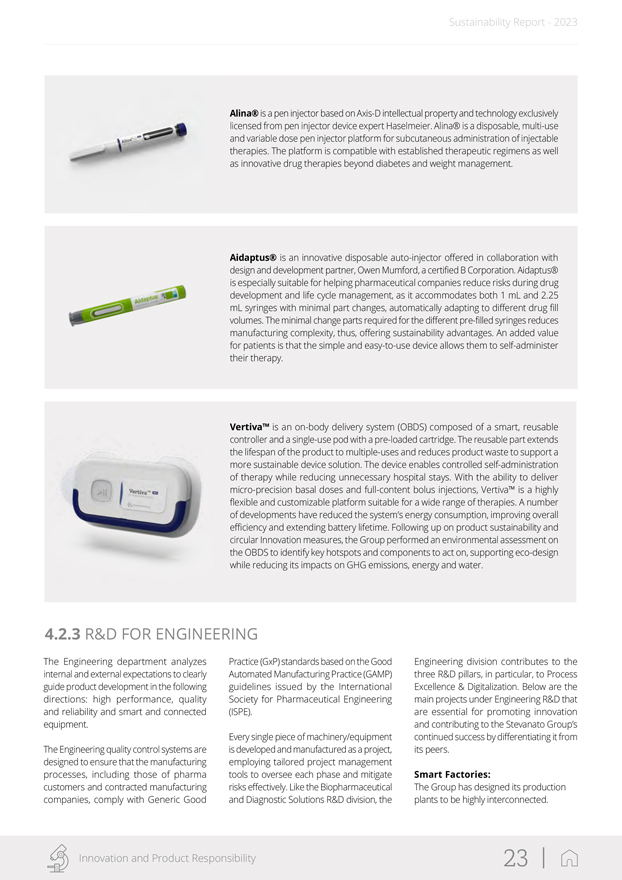
Sustainability Report—2023 Alina® is a pen injector based on Axis-D intellectual property and technology exclusively licensed from pen injector device expert Haselmeier. Alina® is a disposable, multi-use and variable dose pen injector platform for subcutaneous administration of injectable therapies. The platform is compatible with established therapeutic regimens as well as innovative drug therapies beyond diabetes and weight management. Aidaptus® is an innovative disposable auto-injector offered in collaboration with design and development partner, Owen Mumford, a certified B Corporation. Aidaptus® is especially suitable for helping pharmaceutical companies reduce risks during drug development and life cycle management, as it accommodates both 1 mL and 2.25 mL syringes with minimal part changes, automatically adapting to different drug fill volumes. The minimal change parts required for the different pre-filled syringes reduces manufacturing complexity, thus, offering sustainability advantages. An added value for patients is that the simple and easy-to-use device allows them to self-administer their therapy. Vertiva™ is an on-body delivery system (OBDS) composed of a smart, reusable controller and a single-use pod with a pre-loaded cartridge. The reusable part extends the lifespan of the product to multiple-uses and reduces product waste to support a more sustainable device solution. The device enables controlled self-administration of therapy while reducing unnecessary hospital stays. With the ability to deliver micro-precision basal doses and full-content bolus injections, Vertiva™ is a highly flexible and customizable platform suitable for a wide range of therapies. A number of developments have reduced the system’s energy consumption, improving overall efficiency and extending battery lifetime. Following up on product sustainability and circular Innovation measures, the Group performed an environmental assessment on the OBDS to identify key hotspots and components to act on, supporting eco-design while reducing its impacts on GHG emissions, energy and water. 4.2.3 R&D FOR ENGINEERING The Engineering department analyzes internal and external expectations to clearly guide product development in the following directions: high performance, quality and reliability and smart and connected equipment. The Engineering quality control systems are designed to ensure that the manufacturing processes, including those of pharma customers and contracted manufacturing companies, comply with Generic Good Practice (GxP) standards based on the Good Automated Manufacturing Practice (GAMP) guidelines issued by the International Society for Pharmaceutical Engineering (ISPE). Every single piece of machinery/equipment is developed and manufactured as a project, employing tailored project management tools to oversee each phase and mitigate risks effectively. Like the Biopharmaceutical and Diagnostic Solutions R&D division, the Engineering division contributes to the three R&D pillars, in particular, to Process Excellence & Digitalization. Below are the main projects under Engineering R&D that are essential for promoting innovation and contributing to the Stevanato Group’s continued success by differentiating it from its peers. Smart Factories: The Group has designed its production plants to be highly interconnected. Innovation and Product Responsibility 23 |
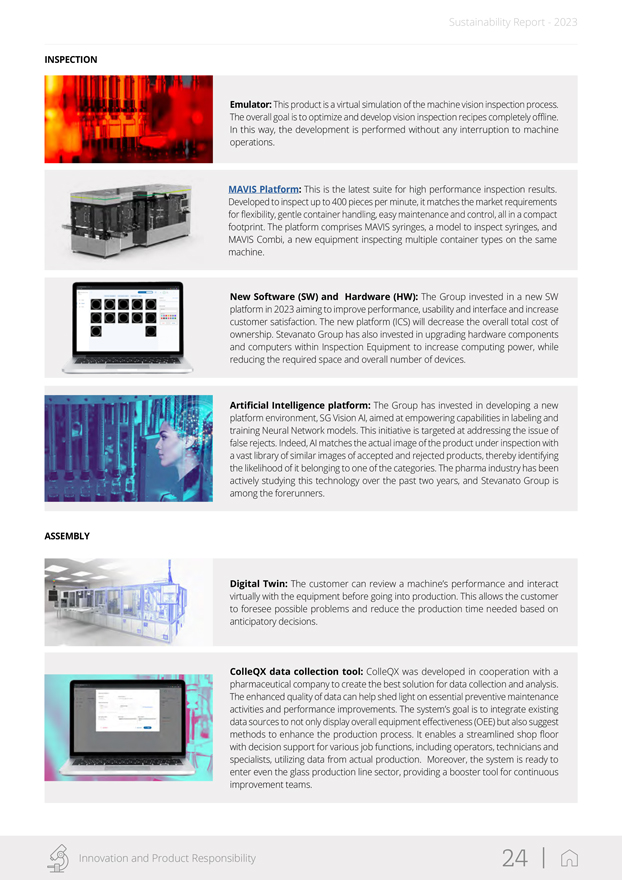
Sustainability Report—2023 INSPECTION ASSEMBLY Emulator: This product is a virtual simulation of the machine vision inspection process. The overall goal is to optimize and develop vision inspection recipes completely offline. In this way, the development is performed without any interruption to machine operations. MAVIS Platform: This is the latest suite for high performance inspection results. Developed to inspect up to 400 pieces per minute, it matches the market requirements for flexibility, gentle container handling, easy maintenance and control, all in a compact footprint. The platform comprises MAVIS syringes, a model to inspect syringes, and MAVIS Combi, a new equipment inspecting multiple container types on the same machine. New Software (SW) and Hardware (HW): The Group invested in a new SW platform in 2023 aiming to improve performance, usability and interface and increase customer satisfaction. The new platform (ICS) will decrease the overall total cost of ownership. Stevanato Group has also invested in upgrading hardware components and computers within Inspection Equipment to increase computing power, while reducing the required space and overall number of devices. Artificial Intelligence platform: The Group has invested in developing a new platform environment, SG Vision AI, aimed at empowering capabilities in labeling and training Neural Network models. This initiative is targeted at addressing the issue of false rejects. Indeed, AI matches the actual image of the product under inspection with a vast library of similar images of accepted and rejected products, thereby identifying the likelihood of it belonging to one of the categories. The pharma industry has been actively studying this technology over the past two years, and Stevanato Group is among the forerunners. Digital Twin: The customer can review a machine’s performance and interact virtually with the equipment before going into production. This allows the customer to foresee possible problems and reduce the production time needed based on anticipatory decisions. ColleQX data collection tool: ColleQX was developed in cooperation with a pharmaceutical company to create the best solution for data collection and analysis. The enhanced quality of data can help shed light on essential preventive maintenance activities and performance improvements. The system’s goal is to integrate existing data sources to not only display overall equipment effectiveness (OEE) but also suggest methods to enhance the production process. It enables a streamlined shop floor with decision support for various job functions, including operators, technicians and specialists, utilizing data from actual production. Moreover, the system is ready to enter even the glass production line sector, providing a booster tool for continuous improvement teams. Innovation and Product Responsibility 24 |
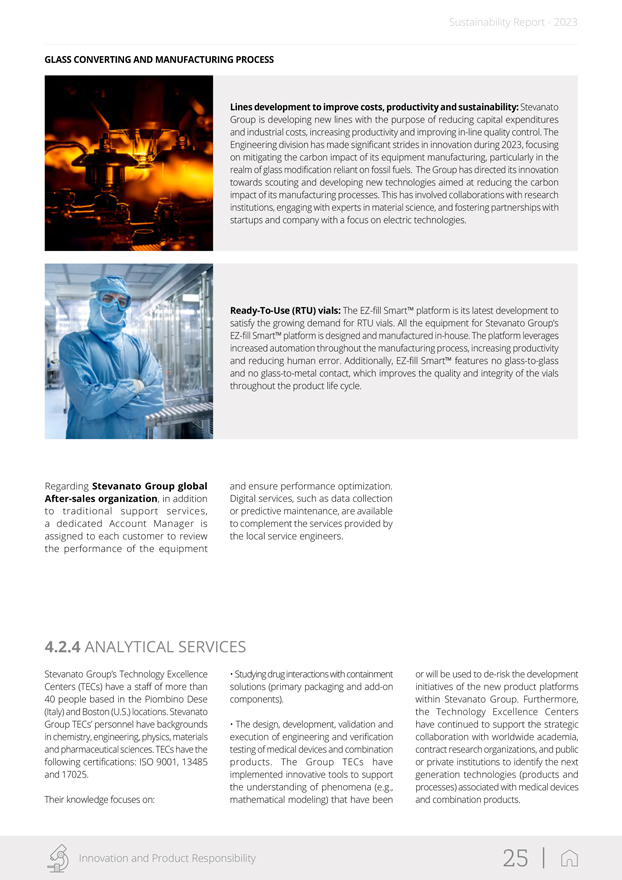
Sustainability Report—2023 GLASS CONVERTING AND MANUFACTURING PROCESS Lines development to improve costs, productivity and sustainability: Stevanato Group is developing new lines with the purpose of reducing capital expenditures and industrial costs, increasing productivity and improving in-line quality control. The Engineering division has made significant strides in innovation during 2023, focusing on mitigating the carbon impact of its equipment manufacturing, particularly in the realm of glass modification reliant on fossil fuels. The Group has directed its innovation towards scouting and developing new technologies aimed at reducing the carbon impact of its manufacturing processes. This has involved collaborations with research institutions, engaging with experts in material science, and fostering partnerships with startups and company with a focus on electric technologies. Ready-To-Use (RTU) vials: The EZ-fill Smart™ platform is its latest development to satisfy the growing demand for RTU vials. All the equipment for Stevanato Group’s EZ-fill Smart™ platform is designed and manufactured in-house. The platform leverages increased automation throughout the manufacturing process, increasing productivity and reducing human error. Additionally, EZ-fill Smart™ features no glass-to-glass and no glass-to-metal contact, which improves the quality and integrity of the vials throughout the product life cycle. Regarding Stevanato Group global After-sales organization, in addition to traditional support services, a dedicated Account Manager is assigned to each customer to review the performance of the equipment and ensure performance optimization. Digital services, such as data collection or predictive maintenance, are available to complement the services provided by the local service engineers. 4.2.4 ANALYTICAL SERVICES Stevanato Group’s Technology Excellence • Studying drug interactions with containment or will be used to de-risk the development Centers (TECs) have a staff of more than solutions (primary packaging and add-on initiatives of the new product platforms 40 people based in the Piombino Dese components). within Stevanato Group. Furthermore, (Italy) and Boston (U.S.) locations. Stevanato the Technology Excellence Centers Group TECs’ personnel have backgrounds • The design, development, validation and have continued to support the strategic in chemistry, engineering, physics, materials execution of engineering and verification collaboration with worldwide academia, and pharmaceutical sciences. TECs have the testing of medical devices and combination contract research organizations, and public following certifications: ISO 9001, 13485 products. The Group TECs have or private institutions to identify the next and 17025. implemented innovative tools to support generation technologies (products and the understanding of phenomena (e.g., processes) associated with medical devices Their knowledge focuses on: mathematical modeling) that have been and combination products. Innovation and Product Responsibility 25 |
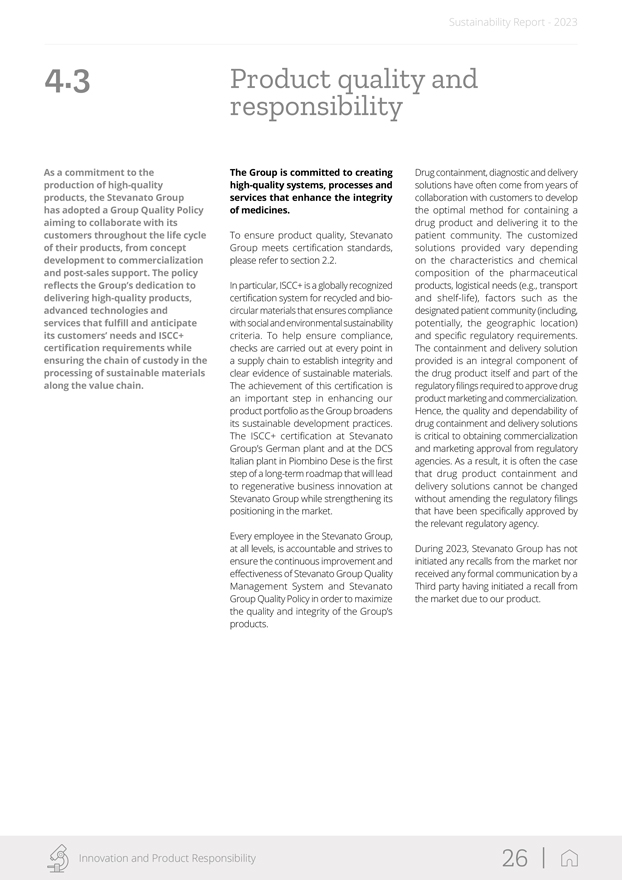
Sustainability Report—2023 4.3 As a commitment to the production of high-quality products, the Stevanato Group has adopted a Group Quality Policy aiming to collaborate with its customers throughout the life cycle of their products, from concept development to commercialization and post-sales support. The policy reflects the Group’s dedication to delivering high-quality products, advanced technologies and services that fulfill and anticipate its customers’ needs and ISCC+ certification requirements while ensuring the chain of custody in the processing of sustainable materials along the value chain. Product quality and responsibility The Group is committed to creating high-quality systems, processes and services that enhance the integrity of medicines. To ensure product quality, Stevanato Group meets certification standards, please refer to section 2.2. In particular, ISCC+ is a globally recognized certification system for recycled and bio-circular materials that ensures compliance with social and environmental sustainability criteria. To help ensure compliance, checks are carried out at every point in a supply chain to establish integrity and clear evidence of sustainable materials. The achievement of this certification is an important step in enhancing our product portfolio as the Group broadens its sustainable development practices. The ISCC+ certification at Stevanato Group’s German plant and at the DCS Italian plant in Piombino Dese is the first step of a long-term roadmap that will lead to regenerative business innovation at Stevanato Group while strengthening its positioning in the market. Every employee in the Stevanato Group, at all levels, is accountable and strives to ensure the continuous improvement and effectiveness of Stevanato Group Quality Management System and Stevanato Group Quality Policy in order to maximize the quality and integrity of the Group’s products. Drug containment, diagnostic and delivery solutions have often come from years of collaboration with customers to develop the optimal method for containing a drug product and delivering it to the patient community. The customized solutions provided vary depending on the characteristics and chemical composition of the pharmaceutical products, logistical needs (e.g., transport and shelf-life), factors such as the designated patient community (including, potentially, the geographic location) and specific regulatory requirements. The containment and delivery solution provided is an integral component of the drug product itself and part of the regulatory filings required to approve drug product marketing and commercialization. Hence, the quality and dependability of drug containment and delivery solutions is critical to obtaining commercialization and marketing approval from regulatory agencies. As a result, it is often the case that drug product containment and delivery solutions cannot be changed without amending the regulatory filings that have been specifically approved by the relevant regulatory agency. During 2023, Stevanato Group has not initiated any recalls from the market nor received any formal communication by a Third party having initiated a recall from the market due to our product. Innovation and Product Responsibility 26 |
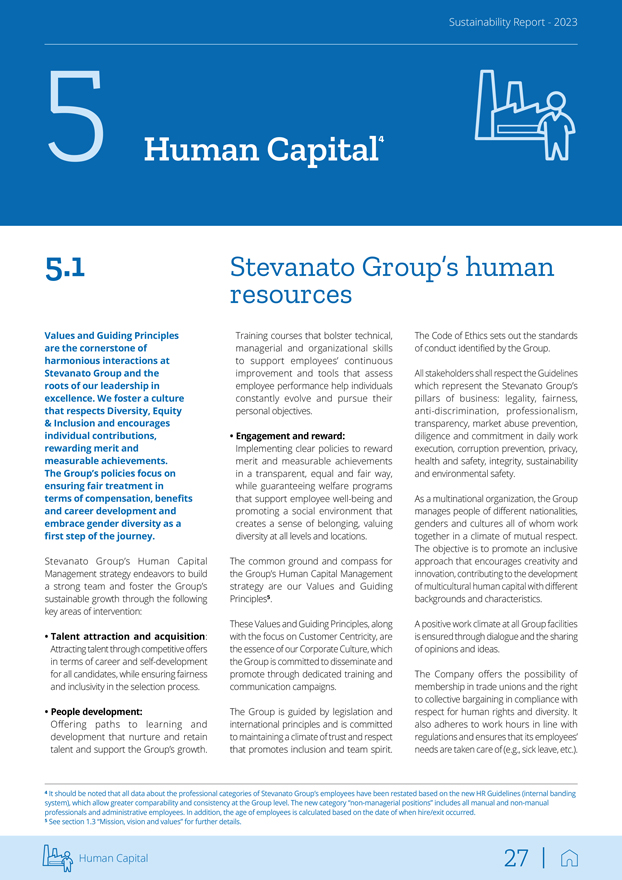
Sustainability Report—2023 5 Human Capitalâ´ 5.1 Values and Guiding Principles are the cornerstone of harmonious interactions at Stevanato Group and the roots of our leadership in excellence. We foster a culture that respects Diversity, Equity & Inclusion and encourages individual contributions, rewarding merit and measurable achievements. The Group’s policies focus on ensuring fair treatment in terms of compensation, benefits and career development and embrace gender diversity as a first step of the journey. Stevanato Group’s Human Capital Management strategy endeavors to build a strong team and foster the Group’s sustainable growth through the following key areas of intervention: • Talent attraction and acquisition: Attracting talent through competitive offers in terms of career and self-development for all candidates, while ensuring fairness and inclusivity in the selection process. • People development: Offering paths to learning and development that nurture and retain talent and support the Group’s growth. Stevanato Group’s human resources Training courses that bolster technical, managerial and organizational skills to support employees’ continuous improvement and tools that assess employee performance help individuals constantly evolve and pursue their personal objectives. • Engagement and reward: Implementing clear policies to reward merit and measurable achievements in a transparent, equal and fair way, while guaranteeing welfare programs that support employee well-being and promoting a social environment that creates a sense of belonging, valuing diversity at all levels and locations. The common ground and compass for the Group’s Human Capital Management strategy are our Values and Guiding Principles5. These Values and Guiding Principles, along with the focus on Customer Centricity, are the essence of our Corporate Culture, which the Group is committed to disseminate and promote through dedicated training and communication campaigns. The Group is guided by legislation and international principles and is committed to maintaining a climate of trust and respect that promotes inclusion and team spirit. The Code of Ethics sets out the standards of conduct identified by the Group. All stakeholders shall respect the Guidelines which represent the Stevanato Group’s pillars of business: legality, fairness, anti-discrimination, professionalism, transparency, market abuse prevention, diligence and commitment in daily work execution, corruption prevention, privacy, health and safety, integrity, sustainability and environmental safety. As a multinational organization, the Group manages people of different nationalities, genders and cultures all of whom work together in a climate of mutual respect. The objective is to promote an inclusive approach that encourages creativity and innovation, contributing to the development of multicultural human capital with different backgrounds and characteristics. A positive work climate at all Group facilities is ensured through dialogue and the sharing of opinions and ideas. The Company offers the possibility of membership in trade unions and the right to collective bargaining in compliance with respect for human rights and diversity. It also adheres to work hours in line with regulations and ensures that its employees’ needs are taken care of (e.g., sick leave, etc.). â´ It should be noted that all data about the professional categories of Stevanato Group’s employees have been restated based on the new HR Guidelines (internal banding system), which allow greater comparability and consistency at the Group level. The new category “non-managerial positions” includes all manual and non-manual professionals and administrative employees. In addition, the age of employees is calculated based on the date of when hire/exit occurred. âµ See section 1.3 “Mission, vision and values” for further details. Human Capital 27 |
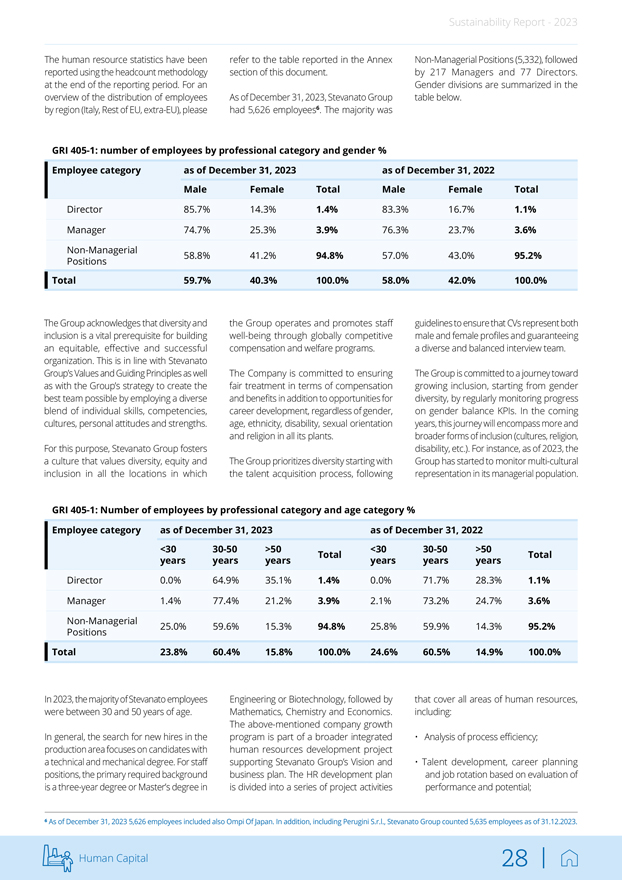
Sustainability Report—2023 The human resource statistics have been reported using the headcount methodology at the end of the reporting period. For an overview of the distribution of employees by region (Italy, Rest of EU, extra-EU), please refer to the table reported in the Annex section of this document. As of December 31, 2023, Stevanato Group had 5,626 employees6. The majority was Non-Managerial Positions (5,332), followed by 217 Managers and 77 Directors. Gender divisions are summarized in the table below. GRI 405-1: number of employees by professional category and gender % Employee category as of December 31, 2023 as of December 31, 2022 Male Female Total Male Female Total Director 85.7% 14.3% 1.4% 83.3% 16.7% 1.1% Manager 74.7% 25.3% 3.9% 76.3% 23.7% 3.6% Non-Managerial 58.8% 41.2% 94.8% 57.0% 43.0% 95.2% Positions Total 59.7% 40.3% 100.0% 58.0% 42.0% 100.0% The Group acknowledges that diversity and inclusion is a vital prerequisite for building an equitable, effective and successful organization. This is in line with Stevanato Group’s Values and Guiding Principles as well as with the Group’s strategy to create the best team possible by employing a diverse blend of individual skills, competencies, cultures, personal attitudes and strengths. For this purpose, Stevanato Group fosters a culture that values diversity, equity and inclusion in all the locations in which the Group operates and promotes staff well-being through globally competitive compensation and welfare programs. The Company is committed to ensuring fair treatment in terms of compensation and benefits in addition to opportunities for career development, regardless of gender, age, ethnicity, disability, sexual orientation and religion in all its plants. The Group prioritizes diversity starting with the talent acquisition process, following guidelines to ensure that CVs represent both male and female profiles and guaranteeing a diverse and balanced interview team. The Group is committed to a journey toward growing inclusion, starting from gender diversity, by regularly monitoring progress on gender balance KPIs. In the coming years, this journey will encompass more and broader forms of inclusion (cultures, religion, disability, etc.). For instance, as of 2023, the Group has started to monitor multi-cultural representation in its managerial population. GRI 405-1: Number of employees by professional category and age category % Employee category as of December 31, 2023 as of December 31, 2022 <30 30-50 >50 <30 30-50 >50 Total Total years years years years years years Director 0.0% 64.9% 35.1% 1.4% 0.0% 71.7% 28.3% 1.1% Manager 1.4% 77.4% 21.2% 3.9% 2.1% 73.2% 24.7% 3.6% Non-Managerial 25.0% 59.6% 15.3% 94.8% 25.8% 59.9% 14.3% 95.2% Positions Total 23.8% 60.4% 15.8% 100.0% 24.6% 60.5% 14.9% 100.0% In 2023, the majority of Stevanato employees were between 30 and 50 years of age. In general, the search for new hires in the production area focuses on candidates with a technical and mechanical degree. For staff positions, the primary required background is a three-year degree or Master’s degree in Engineering or Biotechnology, followed by Mathematics, Chemistry and Economics. The above-mentioned company growth program is part of a broader integrated human resources development project supporting Stevanato Group’s Vision and business plan. The HR development plan is divided into a series of project activities that cover all areas of human resources, including: • Analysis of process efficiency; • Talent development, career planning and job rotation based on evaluation of performance and potential; ⶠAs of December 31, 2023 5,626 employees included also Ompi Of Japan. In addition, including Perugini S.r.l., Stevanato Group counted 5,635 employees as of 31.12.2023. Human Capital 28 |
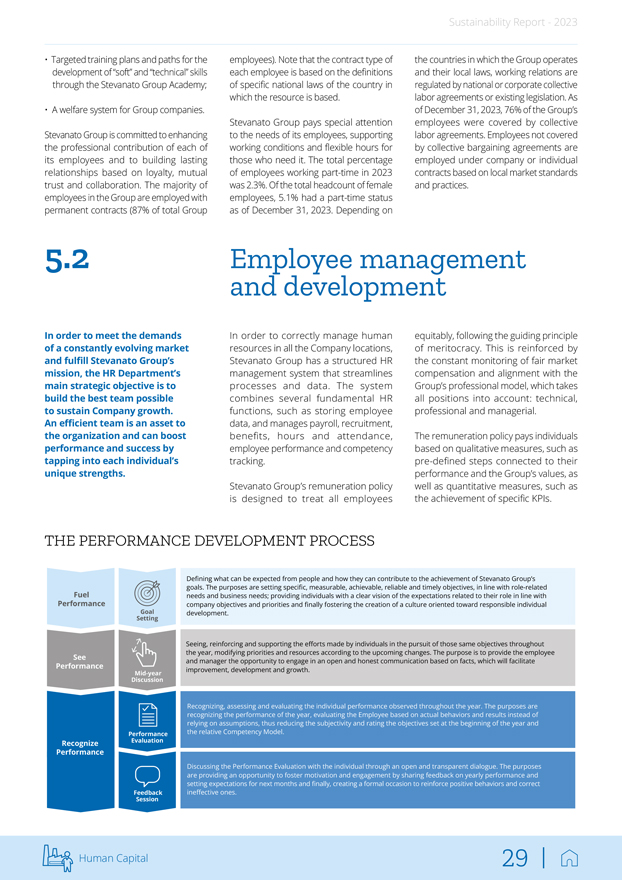
Sustainability Report—2023 • Targeted training plans and paths for the development of “soft” and “technical” skills through the Stevanato Group Academy; • A welfare system for Group companies. Stevanato Group is committed to enhancing the professional contribution of each of its employees and to building lasting relationships based on loyalty, mutual trust and collaboration. The majority of employees in the Group are employed with permanent contracts (87% of total Group employees). Note that the contract type of each employee is based on the definitions of specific national laws of the country in which the resource is based. Stevanato Group pays special attention to the needs of its employees, supporting working conditions and flexible hours for those who need it. The total percentage of employees working part-time in 2023 was 2.3%. Of the total headcount of female employees, 5.1% had a part-time status as of December 31, 2023. Depending on the countries in which the Group operates and their local laws, working relations are regulated by national or corporate collective labor agreements or existing legislation. As of December 31, 2023, 76% of the Group’s employees were covered by collective labor agreements. Employees not covered by collective bargaining agreements are employed under company or individual contracts based on local market standards and practices. 5.2 In order to meet the demands of a constantly evolving market and fulfill Stevanato Group’s mission, the HR Department’s main strategic objective is to build the best team possible to sustain Company growth. An efficient team is an asset to the organization and can boost performance and success by tapping into each individual’s unique strengths. Employee management and development In order to correctly manage human resources in all the Company locations, Stevanato Group has a structured HR management system that streamlines processes and data. The system combines several fundamental HR functions, such as storing employee data, and manages payroll, recruitment, benefits, hours and attendance, employee performance and competency tracking. Stevanato Group’s remuneration policy is designed to treat all employees equitably, following the guiding principle of meritocracy. This is reinforced by the constant monitoring of fair market compensation and alignment with the Group’s professional model, which takes all positions into account: technical, professional and managerial. The remuneration policy pays individuals based on qualitative measures, such as pre-defined steps connected to their performance and the Group’s values, as well as quantitative measures, such as the achievement of specific KPIs. THE PERFORMANCE DEVELOPMENT PROCESS Defining what can be expected from people and how they can contribute to the achievement of Stevanato Group’s Fuel goals. The purposes are setting specific, measurable, achievable, reliable and timely objectives, in line with role-related Performance needs and business needs; providing individuals with a clear vision of the expectations related to their role in line with company objectives and priorities and finally fostering the creation of a culture oriented toward responsible individual Setting Goal development. Seeing, reinforcing and supporting the efforts made by individuals in the pursuit of those same objectives throughout the year, modifying priorities and resources according to the upcoming changes. The purpose is to provide the employee See and manager the opportunity to engage in an open and honest communication based on facts, which will facilitate Performance Mid-year improvement, development and growth. Discussion Recognizing, assessing and evaluating the individual performance observed throughout the year. The purposes are recognizing the performance of the year, evaluating the Employee based on actual behaviors and results instead of relying on assumptions, thus reducing the subjectivity and rating the objectives set at the beginning of the year and Performance the relative Competency Model. Recognize Evaluation Performance Discussing the Performance Evaluation with the individual through an open and transparent dialogue. The purposes are providing an opportunity to foster motivation and engagement by sharing feedback on yearly performance and setting expectations for next months and finally, creating a formal occasion to reinforce positive behaviors and correct Feedback Session ineffective ones. Human Capital 29 |
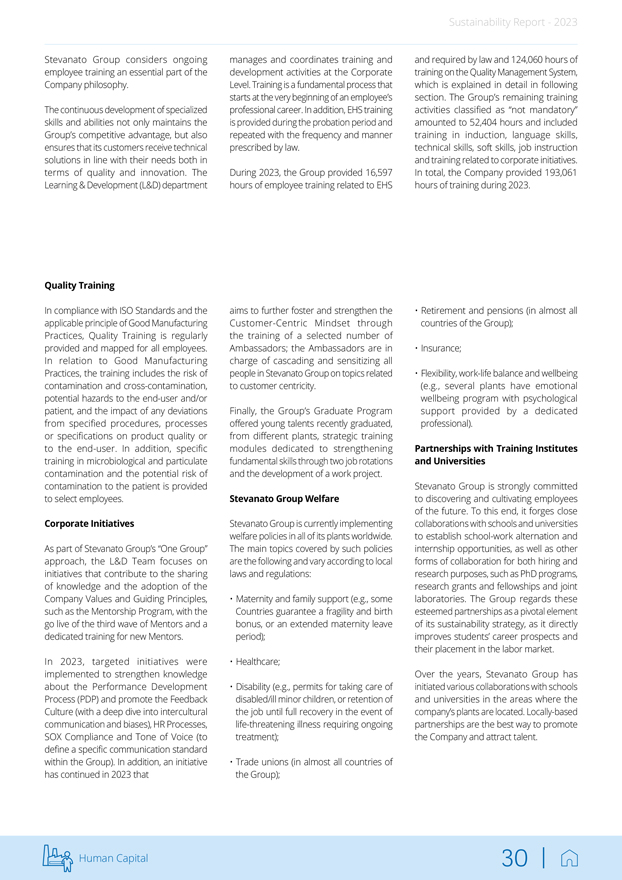
Sustainability Report—2023 Stevanato Group considers ongoing employee training an essential part of the Company philosophy. The continuous development of specialized skills and abilities not only maintains the Group’s competitive advantage, but also ensures that its customers receive technical solutions in line with their needs both in terms of quality and innovation. The Learning & Development (L&D) department Quality Training In compliance with ISO Standards and the applicable principle of Good Manufacturing Practices, Quality Training is regularly provided and mapped for all employees. In relation to Good Manufacturing Practices, the training includes the risk of contamination and cross-contamination, potential hazards to the end-user and/or patient, and the impact of any deviations from specified procedures, processes or specifications on product quality or to the end-user. In addition, specific training in microbiological and particulate contamination and the potential risk of contamination to the patient is provided to select employees. Corporate Initiatives As part of Stevanato Group’s “One Group” approach, the L&D Team focuses on initiatives that contribute to the sharing of knowledge and the adoption of the Company Values and Guiding Principles, such as the Mentorship Program, with the go live of the third wave of Mentors and a dedicated training for new Mentors. In 2023, targeted initiatives were implemented to strengthen knowledge about the Performance Development Process (PDP) and promote the Feedback Culture (with a deep dive into intercultural communication and biases), HR Processes, SOX Compliance and Tone of Voice (to define a specific communication standard within the Group). In addition, an initiative has continued in 2023 that manages and coordinates training and development activities at the Corporate Level. Training is a fundamental process that starts at the very beginning of an employee’s professional career. In addition, EHS training is provided during the probation period and repeated with the frequency and manner prescribed by law. During 2023, the Group provided 16,597 hours of employee training related to EHS aims to further foster and strengthen the Customer-Centric Mindset through the training of a selected number of Ambassadors; the Ambassadors are in charge of cascading and sensitizing all people in Stevanato Group on topics related to customer centricity. Finally, the Group’s Graduate Program offered young talents recently graduated, from different plants, strategic training modules dedicated to strengthening fundamental skills through two job rotations and the development of a work project. Stevanato Group Welfare Stevanato Group is currently implementing welfare policies in all of its plants worldwide. The main topics covered by such policies are the following and vary according to local laws and regulations: • Maternity and family support (e.g., some Countries guarantee a fragility and birth bonus, or an extended maternity leave period); • Healthcare; • Disability (e.g., permits for taking care of disabled/ill minor children, or retention of the job until full recovery in the event of life-threatening illness requiring ongoing treatment); • Trade unions (in almost all countries of the Group); and required by law and 124,060 hours of training on the Quality Management System, which is explained in detail in following section. The Group’s remaining training activities classified as “not mandatory” amounted to 52,404 hours and included training in induction, language skills, technical skills, soft skills, job instruction and training related to corporate initiatives. In total, the Company provided 193,061 hours of training during 2023. • Retirement and pensions (in almost all countries of the Group); • Insurance; • Flexibility, work-life balance and wellbeing (e.g., several plants have emotional wellbeing program with psychological support provided by a dedicated professional). Partnerships with Training Institutes and Universities Stevanato Group is strongly committed to discovering and cultivating employees of the future. To this end, it forges close collaborations with schools and universities to establish school-work alternation and internship opportunities, as well as other forms of collaboration for both hiring and research purposes, such as PhD programs, research grants and fellowships and joint laboratories. The Group regards these esteemed partnerships as a pivotal element of its sustainability strategy, as it directly improves students’ career prospects and their placement in the labor market. Over the years, Stevanato Group has initiated various collaborations with schools and universities in the areas where the company’s plants are located. Locally-based partnerships are the best way to promote the Company and attract talent. Human Capital 30 |
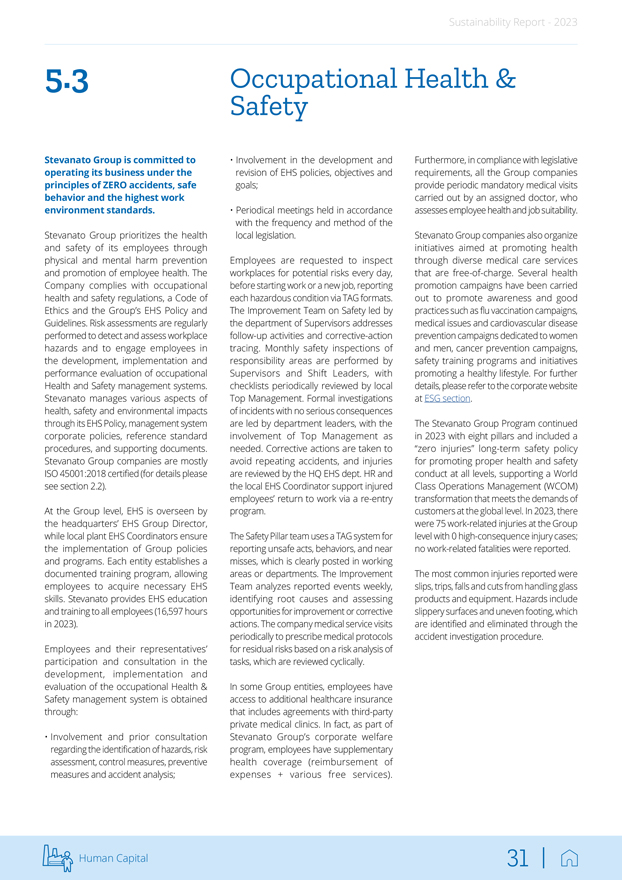
Sustainability Report—2023 5.3 Stevanato Group is committed to operating its business under the principles of ZERO accidents, safe behavior and the highest work environment standards. Stevanato Group prioritizes the health and safety of its employees through physical and mental harm prevention and promotion of employee health. The Company complies with occupational health and safety regulations, a Code of Ethics and the Group’s EHS Policy and Guidelines. Risk assessments are regularly performed to detect and assess workplace hazards and to engage employees in the development, implementation and performance evaluation of occupational Health and Safety management systems. Stevanato manages various aspects of health, safety and environmental impacts through its EHS Policy, management system corporate policies, reference standard procedures, and supporting documents. Stevanato Group companies are mostly ISO 45001:2018 certified (for details please see section 2.2). At the Group level, EHS is overseen by the headquarters’ EHS Group Director, while local plant EHS Coordinators ensure the implementation of Group policies and programs. Each entity establishes a documented training program, allowing employees to acquire necessary EHS skills. Stevanato provides EHS education and training to all employees (16,597 hours in 2023). Employees and their representatives’ participation and consultation in the development, implementation and evaluation of the occupational Health & Safety management system is obtained through: • Involvement and prior consultation regarding the identification of hazards, risk assessment, control measures, preventive measures and accident analysis; Occupational Health & Safety • Involvement in the development and revision of EHS policies, objectives and goals; • Periodical meetings held in accordance with the frequency and method of the local legislation. Employees are requested to inspect workplaces for potential risks every day, before starting work or a new job, reporting each hazardous condition via TAG formats. The Improvement Team on Safety led by the department of Supervisors addresses follow-up activities and corrective-action tracing. Monthly safety inspections of responsibility areas are performed by Supervisors and Shift Leaders, with checklists periodically reviewed by local Top Management. Formal investigations of incidents with no serious consequences are led by department leaders, with the involvement of Top Management as needed. Corrective actions are taken to avoid repeating accidents, and injuries are reviewed by the HQ EHS dept. HR and the local EHS Coordinator support injured employees’ return to work via a re-entry program. The Safety Pillar team uses a TAG system for reporting unsafe acts, behaviors, and near misses, which is clearly posted in working areas or departments. The Improvement Team analyzes reported events weekly, identifying root causes and assessing opportunities for improvement or corrective actions. The company medical service visits periodically to prescribe medical protocols for residual risks based on a risk analysis of tasks, which are reviewed cyclically. In some Group entities, employees have access to additional healthcare insurance that includes agreements with third-party private medical clinics. In fact, as part of Stevanato Group’s corporate welfare program, employees have supplementary health coverage (reimbursement of expenses + various free services). Furthermore, in compliance with legislative requirements, all the Group companies provide periodic mandatory medical visits carried out by an assigned doctor, who assesses employee health and job suitability. Stevanato Group companies also organize initiatives aimed at promoting health through diverse medical care services that are free-of-charge. Several health promotion campaigns have been carried out to promote awareness and good practices such as flu vaccination campaigns, medical issues and cardiovascular disease prevention campaigns dedicated to women and men, cancer prevention campaigns, safety training programs and initiatives promoting a healthy lifestyle. For further details, please refer to the corporate website at ESG section. The Stevanato Group Program continued in 2023 with eight pillars and included a “zero injuries” long-term safety policy for promoting proper health and safety conduct at all levels, supporting a World Class Operations Management (WCOM) transformation that meets the demands of customers at the global level. In 2023, there were 75 work-related injuries at the Group level with 0 high-consequence injury cases; no work-related fatalities were reported. The most common injuries reported were slips, trips, falls and cuts from handling glass products and equipment. Hazards include slippery surfaces and uneven footing, which are identified and eliminated through the accident investigation procedure. Human Capital 31 |
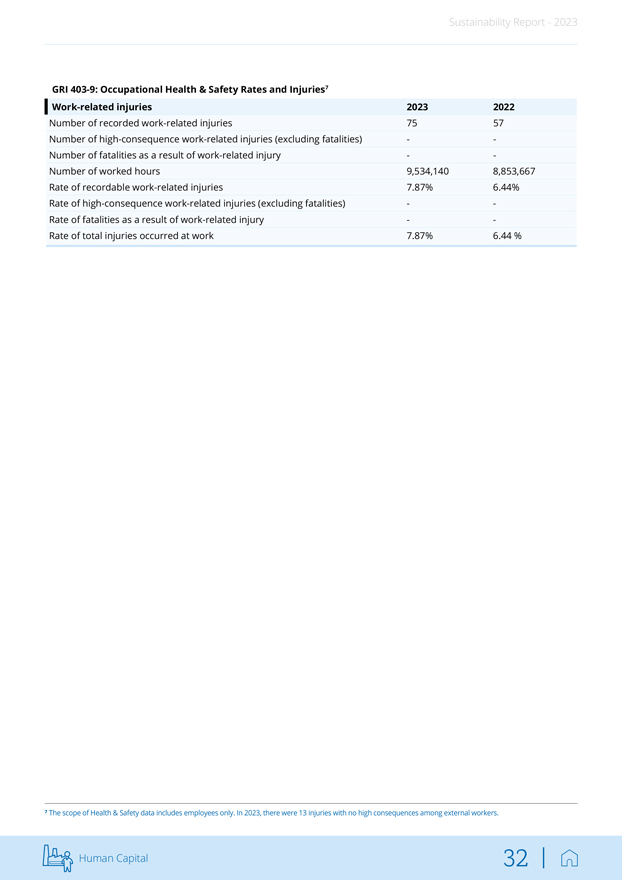
Sustainability Report—2023 GRI 403-9: Occupational Health & Safety Rates and Injuries7 Work-related injuries 2023 2022 Number of recorded work-related injuries 75 57 Number of high-consequence work-related injuries (excluding fatalities) —Number of fatalities as a result of work-related injury —Number of worked hours 9,534,140 8,853,667 Rate of recordable work-related injuries 7.87% 6.44% Rate of high-consequence work-related injuries (excluding fatalities) —Rate of fatalities as a result of work-related injury —Rate of total injuries occurred at work 7.87% 6.44 % â· The scope of Health & Safety data includes employees only. In 2023, there were 13 injuries with no high consequences among external workers. Human Capital 32 |
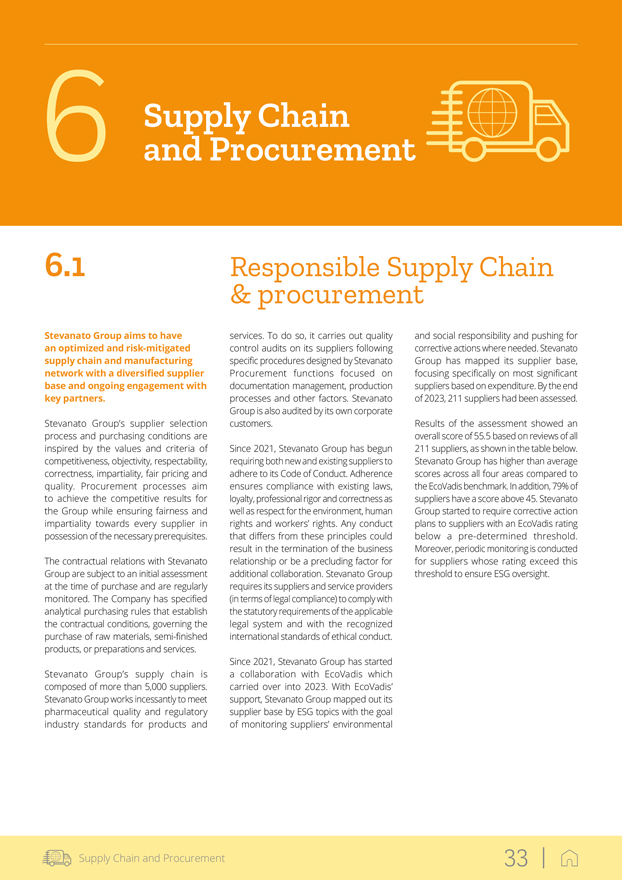
Supply Chain 6and Procurement 6.1 Stevanato Group aims to have an optimized and risk-mitigated supply chain and manufacturing network with a diversified supplier base and ongoing engagement with key partners. Stevanato Group’s supplier selection process and purchasing conditions are inspired by the values and criteria of competitiveness, objectivity, respectability, correctness, impartiality, fair pricing and quality. Procurement processes aim to achieve the competitive results for the Group while ensuring fairness and impartiality towards every supplier in possession of the necessary prerequisites. The contractual relations with Stevanato Group are subject to an initial assessment at the time of purchase and are regularly monitored. The Company has specified analytical purchasing rules that establish the contractual conditions, governing the purchase of raw materials, semi-finished products, or preparations and services. Stevanato Group’s supply chain is composed of more than 5,000 suppliers. Stevanato Group works incessantly to meet pharmaceutical quality and regulatory industry standards for products and Responsible Supply Chain & procurement services. To do so, it carries out quality control audits on its suppliers following specific procedures designed by Stevanato Procurement functions focused on documentation management, production processes and other factors. Stevanato Group is also audited by its own corporate customers. Since 2021, Stevanato Group has begun requiring both new and existing suppliers to adhere to its Code of Conduct. Adherence ensures compliance with existing laws, loyalty, professional rigor and correctness as well as respect for the environment, human rights and workers’ rights. Any conduct that differs from these principles could result in the termination of the business relationship or be a precluding factor for additional collaboration. Stevanato Group requires its suppliers and service providers (in terms of legal compliance) to comply with the statutory requirements of the applicable legal system and with the recognized international standards of ethical conduct. Since 2021, Stevanato Group has started a collaboration with EcoVadis which carried over into 2023. With EcoVadis’ support, Stevanato Group mapped out its supplier base by ESG topics with the goal of monitoring suppliers’ environmental and social responsibility and pushing for corrective actions where needed. Stevanato Group has mapped its supplier base, focusing specifically on most significant suppliers based on expenditure. By the end of 2023, 211 suppliers had been assessed. Results of the assessment showed an overall score of 55.5 based on reviews of all 211 suppliers, as shown in the table below. Stevanato Group has higher than average scores across all four areas compared to the EcoVadis benchmark. In addition, 79% of suppliers have a score above 45. Stevanato Group started to require corrective action plans to suppliers with an EcoVadis rating below a pre-determined threshold. Moreover, periodic monitoring is conducted for suppliers whose rating exceed this threshold to ensure ESG oversight. Supply Chain and Procurement 33 |
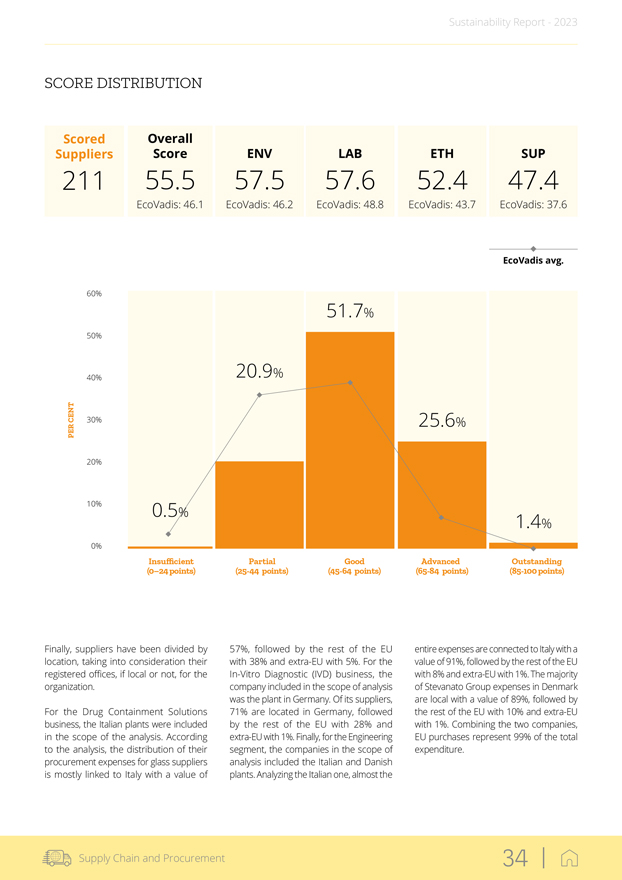
Sustainability Report—2023 SCORE DISTRIBUTION Scored Overall Suppliers Score ENV LAB ETH SUP 211 55.5 57.5 57.6 52.4 47.4 EcoVadis: 46.1 EcoVadis: 46.2 EcoVadis: 48.8 EcoVadis: 43.7 EcoVadis: 37.6 EcoVadis avg. 60% 51.7% 50% 40% 20.9% CENT 30% 25.6% PER 20% 10% 0.5 % 1 .4% 0% Insufficient Partial Good Advanced Outstanding (0–24points) (25-44 points) (45-64 points) (65-84 points) (85-100points) Finally, suppliers have been divided by location, taking into consideration their registered offices, if local or not, for the organization. For the Drug Containment Solutions business, the Italian plants were included in the scope of the analysis. According to the analysis, the distribution of their procurement expenses for glass suppliers is mostly linked to Italy with a value of 57%, followed by the rest of the EU with 38% and extra-EU with 5%. For the In-Vitro Diagnostic (IVD) business, the company included in the scope of analysis was the plant in Germany. Of its suppliers, 71% are located in Germany, followed by the rest of the EU with 28% and extra-EU with 1%. Finally, for the Engineering segment, the companies in the scope of analysis included the Italian and Danish plants. Analyzing the Italian one, almost the entire expenses are connected to Italy with a value of 91%, followed by the rest of the EU with 8% and extra-EU with 1%. The majority of Stevanato Group expenses in Denmark are local with a value of 89%, followed by the rest of the EU with 10% and extra-EU with 1%. Combining the two companies, EU purchases represent 99% of the total expenditure. Supply Chain and Procurement 34 |
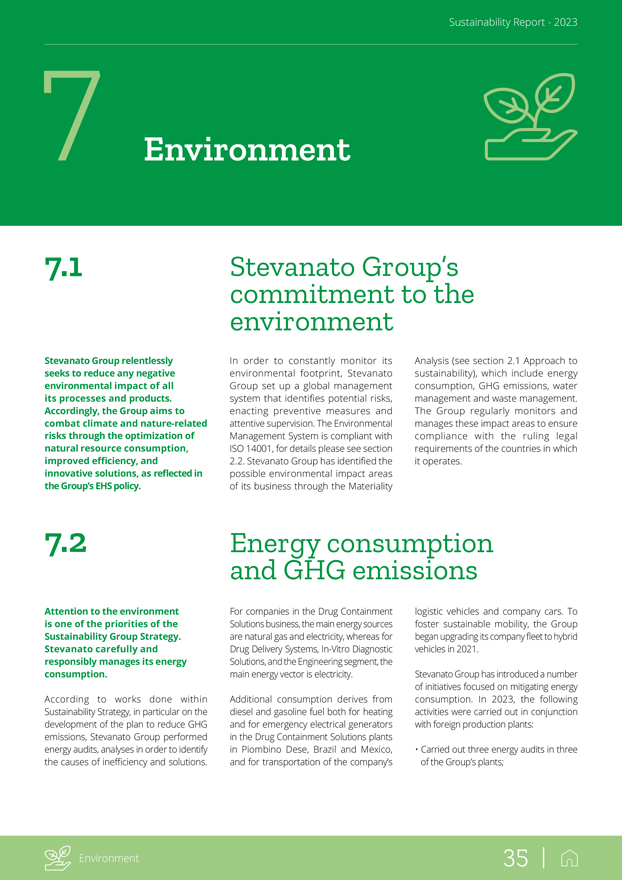
Sustainability Report—2023 7 Environment 7.1 Stevanato Group relentlessly seeks to reduce any negative environmental impact of all its processes and products. Accordingly, the Group aims to combat climate and nature-related risks through the optimization of natural resource consumption, improved efficiency, and innovative solutions, as reflected in the Group’s EHS policy. 7.2 Attention to the environment is one of the priorities of the Sustainability Group Strategy. Stevanato carefully and responsibly manages its energy consumption. According to works done within Sustainability Strategy, in particular on the development of the plan to reduce GHG emissions, Stevanato Group performed energy audits, analyses in order to identify the causes of inefficiency and solutions. Environment Stevanato Group’s commitment to the environment In order to constantly monitor its environmental footprint, Stevanato Group set up a global management system that identifies potential risks, enacting preventive measures and attentive supervision. The Environmental Management System is compliant with ISO 14001, for details please see section 2.2. Stevanato Group has identified the possible environmental impact areas of its business through the Materiality Analysis (see section 2.1 Approach to sustainability), which include energy consumption, GHG emissions, water management and waste management. The Group regularly monitors and manages these impact areas to ensure compliance with the ruling legal requirements of the countries in which it operates. Energy consumption and GHG emissions For companies in the Drug Containment Solutions business, the main energy sources are natural gas and electricity, whereas for Drug Delivery Systems, In-Vitro Diagnostic Solutions, and the Engineering segment, the main energy vector is electricity. Additional consumption derives from diesel and gasoline fuel both for heating and for emergency electrical generators in the Drug Containment Solutions plants in Piombino Dese, Brazil and Mexico, and for transportation of the company’s logistic vehicles and company cars. To foster sustainable mobility, the Group began upgrading its company fleet to hybrid vehicles in 2021. Stevanato Group has introduced a number of initiatives focused on mitigating energy consumption. In 2023, the following activities were carried out in conjunction with foreign production plants: • Carried out three energy audits in three of the Group’s plants; 35 |
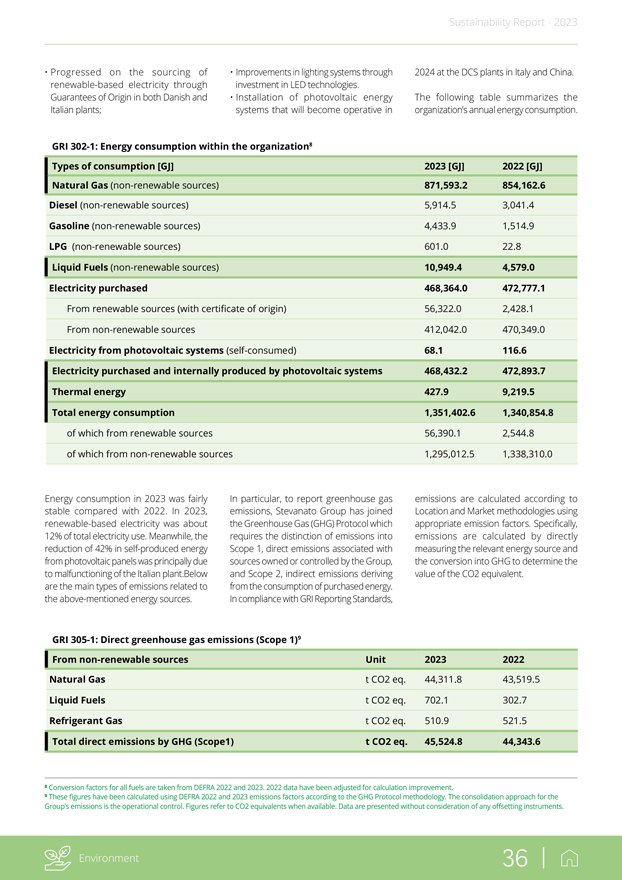
Sustainability Report—2023 • Progressed on the sourcing of renewable-based electricity through Guarantees of Origin in both Danish and Italian plants; • Improvements in lighting systems through 2024 at the DCS plants in Italy and China. investment in LED technologies. • Installation of photovoltaic energy The following table summarizes the systems that will become operative in organization’s annual energy consumption. GRI 302-1: Energy consumption within the organization8 Types of consumption [GJ] 2023 [GJ] 2022 [GJ] Natural Gas (non-renewable sources) 871,593.2 854,162.6 Diesel (non-renewable sources) 5,914.5 3,041.4 Gasoline (non-renewable sources) 4,433.9 1,514.9 LPG (non-renewable sources) 601.0 22.8 Liquid Fuels (non-renewable sources) 10,949.4 4,579.0 Electricity purchased 468,364.0 472,777.1 From renewable sources (with certificate of origin) 56,322.0 2,428.1 From non-renewable sources 412,042.0 470,349.0 Electricity from photovoltaic systems (self-consumed) 68.1 116.6 Electricity purchased and internally produced by photovoltaic systems 468,432.2 472,893.7 Thermal energy 427.9 9,219.5 Total energy consumption 1,351,402.6 1,340,854.8 of which from renewable sources 56,390.1 2,544.8 of which from non-renewable sources 1,295,012.5 1,338,310.0 Energy consumption in 2023 was fairly stable compared with 2022. In 2023, renewable-based electricity was about 12% of total electricity use. Meanwhile, the reduction of 42% in self-produced energy from photovoltaic panels was principally due to malfunctioning of the Italian plant.Below are the main types of emissions related to the above-mentioned energy sources. In particular, to report greenhouse gas emissions, Stevanato Group has joined the Greenhouse Gas (GHG) Protocol which requires the distinction of emissions into Scope 1, direct emissions associated with sources owned or controlled by the Group, and Scope 2, indirect emissions deriving from the consumption of purchased energy. In compliance with GRI Reporting Standards, emissions are calculated according to Location and Market methodologies using appropriate emission factors. Specifically, emissions are calculated by directly measuring the relevant energy source and the conversion into GHG to determine the value of the CO2 equivalent. GRI 305-1: Direct greenhouse gas emissions (Scope 1)9 From non-renewable sources Unit 2023 2022 Natural Gas t CO2 eq. 44,311.8 43,519.5 Liquid Fuels t CO2 eq. 702.1 302.7 Refrigerant Gas t CO2 eq. 510.9 521.5 Total direct emissions by GHG (Scope1) t CO2 eq. 45,524.8 44,343.6 ⸠Conversion factors for all fuels are taken from DEFRA 2022 and2023. 2022 data have been adjusted for calculation improvement. â¹ These figures have been calculated using DEFRA 2022 and 2023 emissions factors according to the GHG Protocol methodology. The consolidation approach for the Group’s emissions is the operational control. Figures refer toCO2 equivalents when available. Data are presented without consideration of any offsetting instruments. Environment 36 |
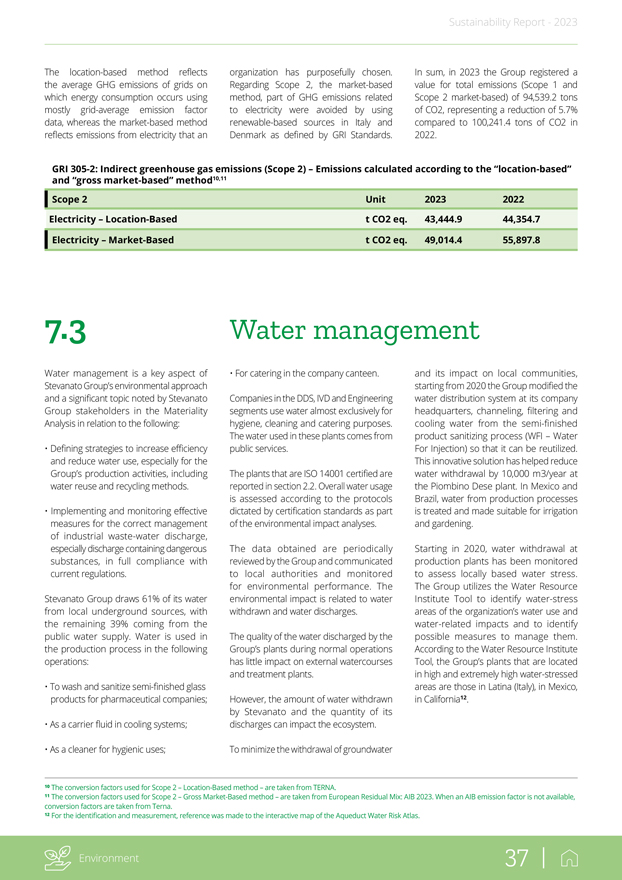
Sustainability Report—2023 The location-based method reflects the average GHG emissions of grids on which energy consumption occurs using mostly grid-average emission factor data, whereas the market-based method reflects emissions from electricity that an organization has purposefully chosen. Regarding Scope 2, the market-based method, part of GHG emissions related to electricity were avoided by using renewable-based sources in Italy and Denmark as defined by GRI Standards. In sum, in 2023 the Group registered a value for total emissions (Scope 1 and Scope 2 market-based) of 94,539.2 tons of CO2, representing a reduction of 5.7% compared to 100,241.4 tons of CO2 in 2022. GRI 305-2: Indirect greenhouse gas emissions (Scope 2) – Emissions calculated according to the “location-based” and “gross market-based” method10,11 Scope 2 Unit 2023 2022 Electricity – Location-Based t CO2 eq. 43,444.9 44,354.7 Electricity – Market-Based t CO2 eq. 49,014.4 55,897.8 7.3 Water management is a key aspect of Stevanato Group’s environmental approach and a significant topic noted by Stevanato Group stakeholders in the Materiality Analysis in relation to the following: • Defining strategies to increase efficiency and reduce water use, especially for the Group’s production activities, including water reuse and recycling methods. • Implementing and monitoring effective measures for the correct management of industrial waste-water discharge, especially discharge containing dangerous substances, in full compliance with current regulations. Stevanato Group draws 61% of its water from local underground sources, with the remaining 39% coming from the public water supply. Water is used in the production process in the following operations: • To wash and sanitize semi-finished glass products for pharmaceutical companies; • As a carrier fluid in cooling systems; • As a cleaner for hygienic uses; Water management • For catering in the company canteen. Companies in the DDS, IVD and Engineering segments use water almost exclusively for hygiene, cleaning and catering purposes. The water used in these plants comes from public services. The plants that are ISO 14001 certified are reported in section 2.2. Overall water usage is assessed according to the protocols dictated by certification standards as part of the environmental impact analyses. The data obtained are periodically reviewed by the Group and communicated to local authorities and monitored for environmental performance. The environmental impact is related to water withdrawn and water discharges. The quality of the water discharged by the Group’s plants during normal operations has little impact on external watercourses and treatment plants. However, the amount of water withdrawn by Stevanato and the quantity of its discharges can impact the ecosystem. To minimize the withdrawal of groundwater and its impact on local communities, starting from 2020 the Group modified the water distribution system at its company headquarters, channeling, filtering and cooling water from the semi-finished product sanitizing process (WFI – Water For Injection) so that it can be reutilized. This innovative solution has helped reduce water withdrawal by 10,000 m3/year at the Piombino Dese plant. In Mexico and Brazil, water from production processes is treated and made suitable for irrigation and gardening. Starting in 2020, water withdrawal at production plants has been monitored to assess locally based water stress. The Group utilizes the Water Resource Institute Tool to identify water-stress areas of the organization’s water use and water-related impacts and to identify possible measures to manage them. According to the Water Resource Institute Tool, the Group’s plants that are located in high and extremely high water-stressed areas are those in Latina (Italy), in Mexico, in California12. ¹â° The conversion factors used for Scope 2 – Location-Based method – are taken from TERNA. ¹¹ The conversion factors used for Scope 2 – Gross Market-Based method – are taken from European Residual Mix: AIB 2023. When an AIB emission factor is not available, conversion factors are taken from Terna. ¹² For the identification and measurement, reference was made to the interactive map of the Aqueduct Water Risk Atlas. Environment 37 |

Sustainability Report—2023 GRI 303-3 2018: Water withdrawal As of December 31, 2023 As of December 31, 2022 Areas with Areas with Unit of Measure: Megaliters All areas All areas water stress water stress Groundwater (total) 271.9 45.5 253.1 38.6 Freshwater (≤1,000 mg/L Total Dissolved Solids) — —Other water (>1,000 mg/L Total Dissolved Solids) 271.9 45.5 253.1 38.6 Third-party water (total)13 172.7 24.7 84.8 26.4 Freshwater (≤1,000 mg/L Total Dissolved Solids) 172.7 24.7 61.2 22.4 Other water (>1,000 mg/L Total Dissolved Solids) — 23.6 4.0 Total water withdrawal 444.6 70.2 337.9 65.0 Water withdrawal data are calculated based on the official figures reported in the water supplier’s documentation, which notes the amount of water withdrawn from public service. In order to accurately monitor the volume of water taken from underground sources, a specific water meter has been installed. In 2023, the increase in the amount of water withdrawn was mainly related to increased production and personnel. In terms of water discharge, effluents are monitored in accordance with regular and precise chemical analyses, which are regulated by a monitoring and control procedure by the operating unit. Generally, water effluents from the Group’s offices and production plants are discharged into the public sewer system based on a specific contract, which also outlines the acceptable limits in compliance with legislation. The data presented below are the result of measurements where available and estimations. In China, the Group carries out real-time monitoring of water discharge by means of special instrumentation prepared in cooperation with local authorities. Overall, Stevanato Group’s plants manage water discharge in accordance with local requirements. It is important to note that water discharge from production facilities, which is mainly the result of sanitization, does not have a significant environmental impact. GRI 303-4 (2018): Water discharge As of December 31, 2023 As of December 31, 2022 Areas with Areas with Unit of Measure: Megaliters All areas All areas water stress water stress Surface water 16.0 16.0 17.2 13.4 Third party water 191.0 24.0 126.0 5.9 Freshwater (≤1,000 mg/L Total Dissolved Solids) Other water (>1,000 mg/L Total Dissolved Solids) 28.5 23.5 33.9 0.1—delivered to treatment plant Other water (>1,000 mg/L Total Dissolved Solids) 162.5 0.5 92.1 5.8—other Total water discharge 207.0 40.0 143.2 19.3 Freshwater —(≤1,000 mg/L Total Dissolved Solids) Other water 207.0 40.0 143.2 19.3 (>1,000 mg/L Total Dissolved Solids) ¹³ Third-party water withdrawal for water-stressed areas is from surface water, with 24.7 Ml as of 31/12/2023 and 26.4 Ml in 31/12/2022. Environment 38 |

Sustainability Report—2023 7.4 Stevanato Group is dedicated to reducing natural resource consumption related to processes and products over their entire life cycles. Stevanato Group pays special attention to waste production, respecting all the mandatory regulations in every country in which it operates. As defined in the EHS Policy, the Group strives to minimize the total amount of waste using the best available techniques and reports results to stakeholders. The waste produced by the Group’s companies derives from the production processes and comes mainly from warehousing (packaging materials), production (production and quality waste) and ancillary activities, such as maintenance and office work. The plants dedicated to the production of glass primary packaging generate several types of waste depending on the manufacturing operations. Stevanato Waste management stresses the importance of circularity in its production process as per the corporate sustainability and circular innovation measures. Its Waste to Value practices give new purpose to material like glass and plastics scraps that would otherwise become trash. Stevanato Group’s German plant also recycles in-process trays as part of the plant’s circular loop. The Group’s waste management process involves collecting and storing waste in designated areas and specific containers according to the type of waste. Volumes are controlled by measuring the masses delivered to the disposal plants. The relevant data are stored in a specific database for each plant and shared at the Group level so that it can be monitored by the central EHS department. Waste for disposal is entrusted to third parties, which operate in compliance with the relevant contractual or legal regulations. Moreover, to improve its waste management methods, Stevanato Group has begun exploring new opportunities to expand its corporate sustainability and circular innovation measures. All the Drug Containment Solutions plants are committed to implementing glass scraps reuse through specialized partners, which convert waste into new raw material. In specific instances where solutions are not found, alternative improvements are pursued. Following this principle, the glass primary packaging plants are working on developing a waste treatment line that grinds scraps and selects materials to produce glass granulate. In 2023, hazardous waste accounted for 6% of the total volume of waste produced, down from 8% in 2022. Waste production increased (+6%) in 2023, due to new departments and startup areas after the building phase ended in 2021. According to the disposal method, 88% of the total amount of waste in 2023 was prepared to recycling, treatment or reuse. GRI 306-3 (2020): Waste generated14 As of December 31, 2023 As of December 31, 2022 Recyclable Not Total Recyclable Not Total Recyclable Recyclable DCS Business 7,225 749 7,974 6,793 1,459 8,252 DDS, IVD Business 1,084 412 1,496 565 190 755 Engineering Business 171 49 220 131 40 171 Total 8,480 1,211 9,691 7,489 1,689 9,178 WASTE BY DISPOSAL METHOD Treatment 20% Incineration 4% Recycling and reclamation Land disposal 66% 8% Reuse 2% ¹â´ No additional information are provided for confidentiality reasons. Environment 39 |
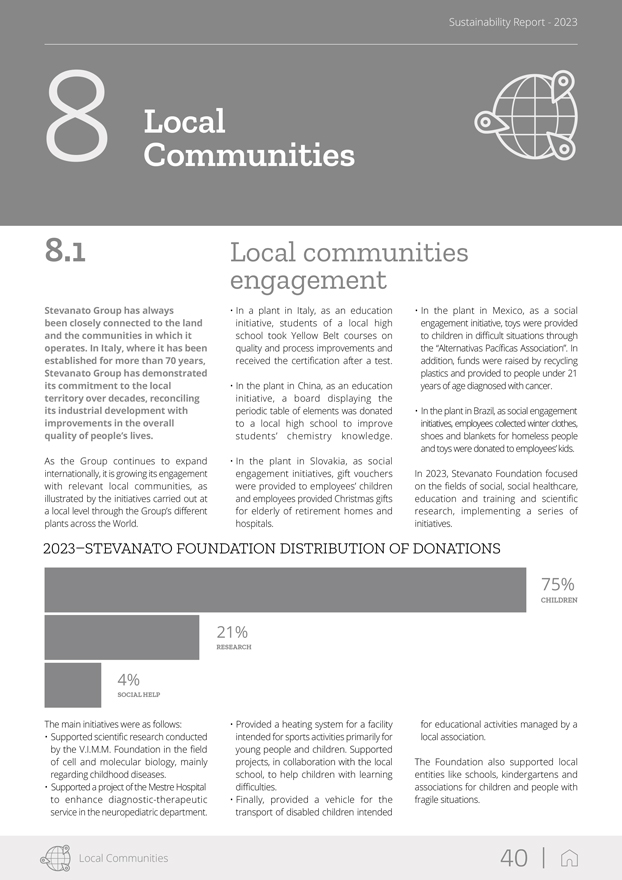
Sustainability Report—2023 8Local Communities 8.1 Stevanato Group has always been closely connected to the land and the communities in which it operates. In Italy, where it has been established for more than 70 years, Stevanato Group has demonstrated its commitment to the local territory over decades, reconciling its industrial development with improvements in the overall quality of people’s lives. As the Group continues to expand internationally, it is growing its engagement with relevant local communities, as illustrated by the initiatives carried out at a local level through the Group’s different plants across the World. Local communities engagement • In a plant in Italy, as an education initiative, students of a local high school took Yellow Belt courses on quality and process improvements and received the certification after a test. • In the plant in China, as an education initiative, a board displaying the periodic table of elements was donated to a local high school to improve students’ chemistry knowledge. • In the plant in Slovakia, as social engagement initiatives, gift vouchers were provided to employees’ children and employees provided Christmas gifts for elderly of retirement homes and hospitals. • In the plant in Mexico, as a social engagement initiative, toys were provided to children in difficult situations through the “Alternativas Pacíficas Association”. In addition, funds were raised by recycling plastics and provided to people under 21 years of age diagnosed with cancer. • In the plant in Brazil, as social engagement initiatives, employees collected winter clothes, shoes and blankets for homeless people and toys were donated to employees’ kids. In 2023, Stevanato Foundation focused on the fields of social, social healthcare, education and training and scientific research, implementing a series of initiatives. 2023–STEVANATO FOUNDATION DISTRIBUTION OF DONATIONS 4% SOCIAL HELP The main initiatives were as follows: • Supported scientific research conducted by the V.I.M.M. Foundation in the field of cell and molecular biology, mainly regarding childhood diseases. • Supported a project of the Mestre Hospital to enhance diagnostic-therapeutic service in the neuropediatric department. 21% RESEARCH • Provided a heating system for a facility intended for sports activities primarily for young people and children. Supported projects, in collaboration with the local school, to help children with learning difficulties. • Finally, provided a vehicle for the transport of disabled children intended 75% CHILDREN for educational activities managed by a local association. The Foundation also supported local entities like schools, kindergartens and associations for children and people with fragile situations. Local Communities 40 |
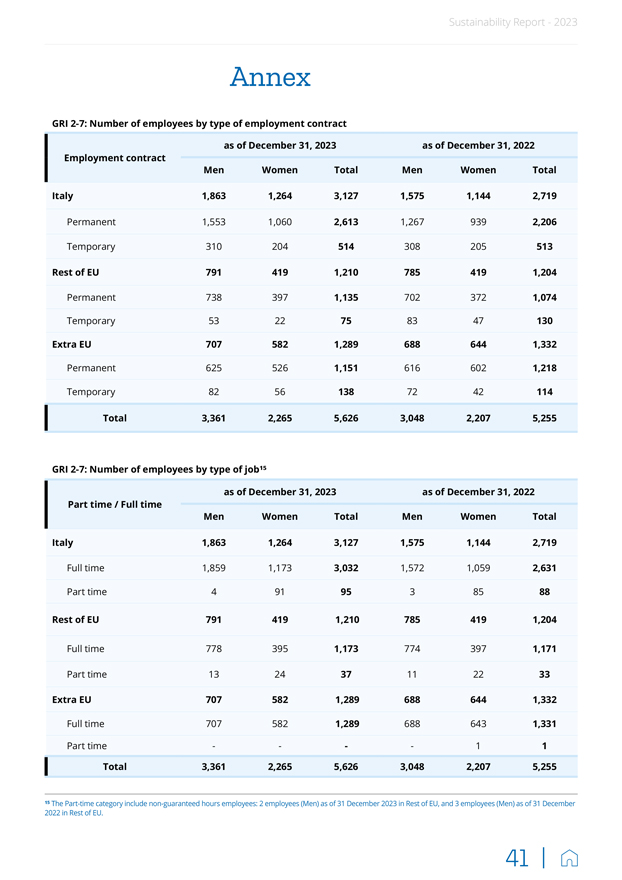
Sustainability Report—2023 Annex GRI 2-7: Number of employees by type of employment contract as of December 31, 2023 as of December 31, 2022 Employment contract Men Women Total Men Women Total Italy 1,863 1,264 3,127 1,575 1,144 2,719 Permanent 1,553 1,060 2,613 1,267 939 2,206 Temporary 310 204 514 308 205 513 Rest of EU 791 419 1,210 785 419 1,204 Permanent 738 397 1,135 702 372 1,074 Temporary 53 22 75 83 47 130 Extra EU 707 582 1,289 688 644 1,332 Permanent 625 526 1,151 616 602 1,218 Temporary 82 56 138 72 42 114 Total 3,361 2,265 5,626 3,048 2,207 5,255 GRI 2-7: Number of employees by type of job¹âµ as of December 31, 2023 as of December 31, 2022 Part time / Full time Men Women Total Men Women Total Italy 1,863 1,264 3,127 1,575 1,144 2,719 Full time 1,859 1,173 3,032 1,572 1,059 2,631 Part time 4 91 95 3 85 88 Rest of EU 791 419 1,210 785 419 1,204 Full time 778 395 1,173 774 397 1,171 Part time 13 24 37 11 22 33 Extra EU 707 582 1,289 688 644 1,332 Full time 707 582 1,289 688 643 1,331 Part time — — 1 1 Total 3,361 2,265 5,626 3,048 2,207 5,255 ¹âµ The Part-time category include non-guaranteed hours employees: 2 employees (Men) as of 31 December 2023 in Rest of EU, and 3employees (Men) as of 31 December 2022 in Rest of EU. 41 |
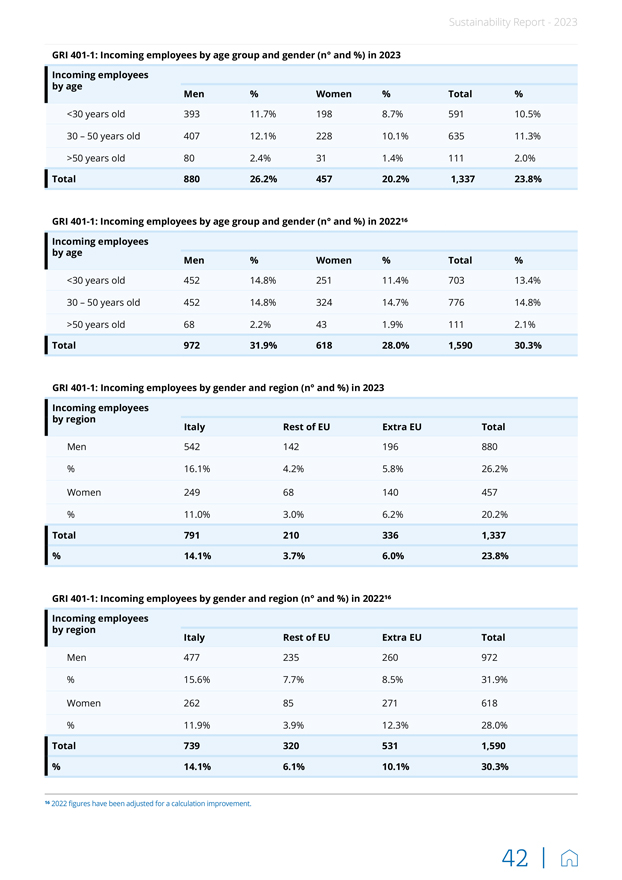
Sustainability Report—2023 GRI 401-1: Incoming employees by age group and gender (n° and %) in 2023 Incoming employees by age Men % Women % Total % <30 years old 393 11.7% 198 8.7% 591 10.5% 30 – 50 years old 407 12.1% 228 10.1% 635 11.3% >50 years old 80 2.4% 31 1.4% 111 2.0% Total 880 26.2% 457 20.2% 1,337 23.8% GRI 401-1: Incoming employees by age group and gender (n° and %) in 2022¹â¶ Incoming employees by age Men % Women % Total % <30 years old 452 14.8% 251 11.4% 703 13.4% 30 – 50 years old 452 14.8% 324 14.7% 776 14.8% >50 years old 68 2.2% 43 1.9% 111 2.1% Total 972 31.9% 618 28.0% 1,590 30.3% GRI 401-1: Incoming employees by gender and region (n° and %) in 2023 Incoming employees by region Italy Rest of EU Extra EU Total Men 542 142 196 880 % 16.1% 4.2% 5.8% 26.2% Women 249 68 140 457 % 11.0% 3.0% 6.2% 20.2% Total 791 210 336 1,337 % 14.1% 3.7% 6.0% 23.8% GRI 401-1: Incoming employees by gender and region (n° and %) in 2022¹â¶ Incoming employees by region Italy Rest of EU Extra EU Total Men 477 235 260 972 % 15.6% 7.7% 8.5% 31.9% Women 262 85 271 618 % 11.9% 3.9% 12.3% 28.0% Total 739 320 531 1,590 % 14.1% 6.1% 10.1% 30.3% ¹â¶ 2022 figures have been adjusted for a calculation improvement. 42 |
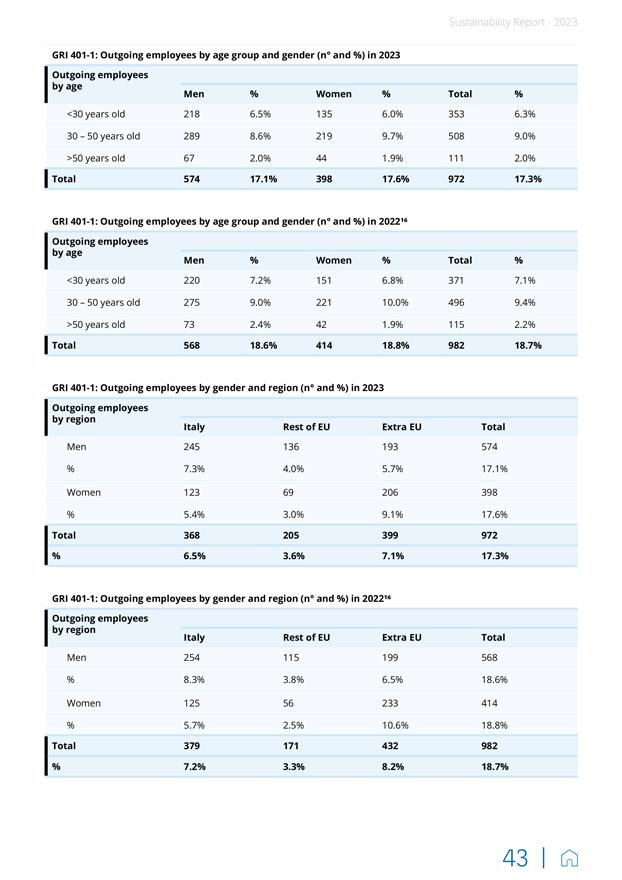
Sustainability Report—2023 GRI 401-1: Outgoing employees by age group and gender (n° and %) in 2023 Outgoing employees by age Men % Women % Total % <30 years old 218 6.5% 135 6.0% 353 6.3% 30 – 50 years old 289 8.6% 219 9.7% 508 9.0% >50 years old 67 2.0% 44 1.9% 111 2.0% Total 574 17.1% 398 17.6% 972 17.3% GRI 401-1: Outgoing employees by age group and gender (n° and %) in 2022¹â¶ Outgoing employees by age Men % Women % Total % <30 years old 220 7.2% 151 6.8% 371 7.1% 30 – 50 years old 275 9.0% 221 10.0% 496 9.4% >50 years old 73 2.4% 42 1.9% 115 2.2% Total 568 18.6% 414 18.8% 982 18.7% GRI 401-1: Outgoing employees by gender and region (n° and %) in 2023 Outgoing employees by region Italy Rest of EU Extra EU Total Men 245 136 193 574 % 7.3% 4.0% 5.7% 17.1% Women 123 69 206 398 % 5.4% 3.0% 9.1% 17.6% Total 368 205 399 972 % 6.5% 3.6% 7.1% 17.3% GRI 401-1: Outgoing employees by gender and region (n° and %) in 2022¹â¶ Outgoing employees by region Italy Rest of EU Extra EU Total Men 254 115 199 568 % 8.3% 3.8% 6.5% 18.6% Women 125 56 233 414 % 5.7% 2.5% 10.6% 18.8% Total 379 171 432 982 % 7.2% 3.3% 8.2% 18.7% 43 |

Sustainability Report—2023 GRI content index Statement Stevanato Group has reported the information cited in this GRI content index for the period 1 January of use to 31 December with reference to the GRI Standards. GRI 1 used GRI 1: Foundation 2021 PAGE NUM. / GRI STANDARD DISCLOSURE LOCATION NOTES GRI 2: 2-1 Organizational details Back cover—General Disclosures Organizational details p. 7-9 2021 2-2 Entities included in the organization’s Methodological note p. V sustainability reporting 2-3 Reporting period, frequency and contact Methodological note p. V point 2-4 Restatements of information Methodological note p. V 2-5 External assurance Methodological note p. V Independent Audit Report p. 48-50 2-6 Activities, value chain and other business Organizational details p. 7-9 relationships Responsible supply chain & p. 33-34 procurement 2-7 Employees Stevanato Group’s human resources p. 27-29 Annex p. 41 2-9 Governance structure and composition The company structure and main p. 11 corporate functions 2-22 Statement on sustainable development Letter to Stakeholders p. IV strategy 2-23 Policy commitments Ethics, integrity and compliance p. 12 2-27 Compliance with laws and regulations Ethics, integrity and compliance p. 12 2-28 Membership associations Participation in organizations and p. 16 associations 2-29 Approach to stakeholder engagement Approach to sustainability p. 13-15 2-30 Collective bargaining agreements Stevanato Group’s human resources p. 29 GRI 3: 3-1 Process to determine material topics Approach to sustainability p. 13-15 Material Topics 3-2 List of material topics Approach to sustainability p. 14 2021 Economic performance and value creation GRI 3: 3-3 Management of material topics Approach to sustainability p. 13-15 Material Topics 2021 Stakeholder value creation p. 17 GRI 201: 201-1 Direct economic value generated and Stakeholder value creation p. 17 Economic distributed Performance 2016 44 |
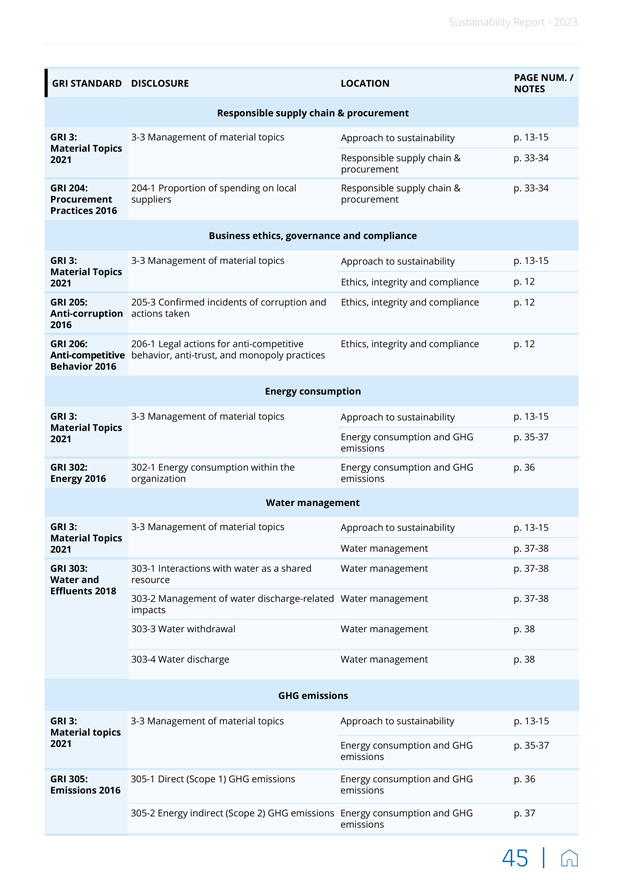
Sustainability Report—2023 PAGE NUM. / GRI STANDARD DISCLOSURE LOCATION NOTES Responsible supply chain & procurement GRI 3: 3-3 Management of material topics Approach to sustainability p. 13-15 Material Topics Responsible supply chain & p. 33-34 2021 procurement GRI 204: 204-1 Proportion of spending on local Responsible supply chain & p. 33-34 Procurement suppliers procurement Practices 2016 Business ethics, governance and compliance GRI 3: 3-3 Management of material topics Approach to sustainability p. 13-15 Material Topics Ethics, integrity and compliance p. 12 2021 GRI 205: 205-3 Confirmed incidents of corruption and Ethics, integrity and compliance p. 12 Anti-corruption actions taken 2016 GRI 206: 206-1 Legal actions for anti-competitive Ethics, integrity and compliance p. 12 Anti-competitive behavior, anti-trust, and monopoly practices Behavior 2016 Energy consumption GRI 3: 3-3 Management of material topics Approach to sustainability p. 13-15 Material Topics Energy consumption and GHG p. 35-37 2021 emissions GRI 302: 302-1 Energy consumption within the Energy consumption and GHG p. 36 Energy 2016 organization emissions Water management GRI 3: 3-3 Management of material topics Approach to sustainability p. 13-15 Material Topics Water management p. 37-38 2021 GRI 303: 303-1 Interactions with water as a shared Water management p. 37-38 Water and resource Effluents 2018 303-2 Management of water discharge-related Water management p. 37-38 impacts 303-3 Water withdrawal Water management p. 38 303-4 Water discharge Water management p. 38 GHG emissions GRI 3: 3-3 Management of material topics Approach to sustainability p. 13-15 Material topics 2021 Energy consumption and GHG p. 35-37 emissions GRI 305: 305-1 Direct (Scope 1) GHG emissions Energy consumption and GHG p. 36 Emissions 2016 emissions 305-2 Energy indirect (Scope 2) GHG emissions Energy consumption and GHG p. 37 emissions 45 |
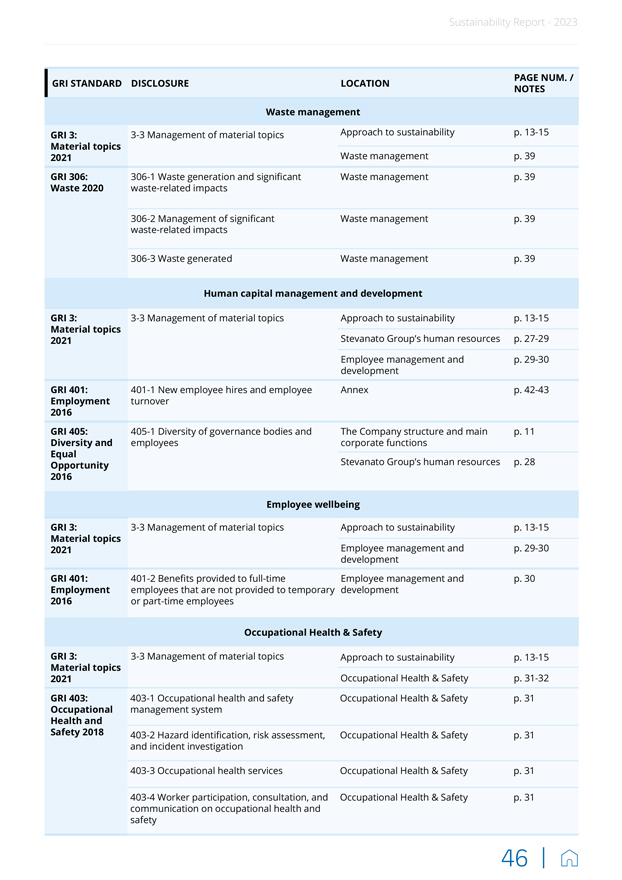
Sustainability Report—2023 PAGE NUM. / GRI STANDARD DISCLOSURE LOCATION NOTES Waste management GRI 3: 3-3 Management of material topics Approach to sustainability p. 13-15 Material topics Waste management p. 39 2021 GRI 306: 306-1 Waste generation and significant Waste management p. 39 Waste 2020 waste-related impacts 306-2 Management of significant Waste management p. 39 waste-related impacts 306-3 Waste generated Waste management p. 39 Human capital management and development GRI 3: 3-3 Management of material topics Approach to sustainability p. 13-15 Material topics Stevanato Group’s human resources p. 27-29 2021 Employee management and p. 29-30 development GRI 401: 401-1 New employee hires and employee Annex p. 42-43 Employment turnover 2016 GRI 405: 405-1 Diversity of governance bodies and The Company structure and main p. 11 Diversity and employees corporate functions Equal Opportunity Stevanato Group’s human resources p. 28 2016 Employee wellbeing GRI 3: 3-3 Management of material topics Approach to sustainability p. 13-15 Material topics Employee management and p. 29-30 2021 development GRI 401: 401-2 Benefits provided to full-time Employee management and p. 30 Employment employees that are not provided to temporary development 2016 or part-time employees Occupational Health & Safety GRI 3: 3-3 Management of material topics Approach to sustainability p. 13-15 Material topics Occupational Health & Safety p. 31-32 2021 GRI 403: 403-1 Occupational health and safety Occupational Health & Safety p. 31 Occupational management system Health and Safety 2018 403-2 Hazard identification, risk assessment, Occupational Health & Safety p. 31 and incident investigation 403-3 Occupational health services Occupational Health & Safety p. 31 403-4 Worker participation, consultation, and Occupational Health & Safety p. 31 communication on occupational health and safety 46 |
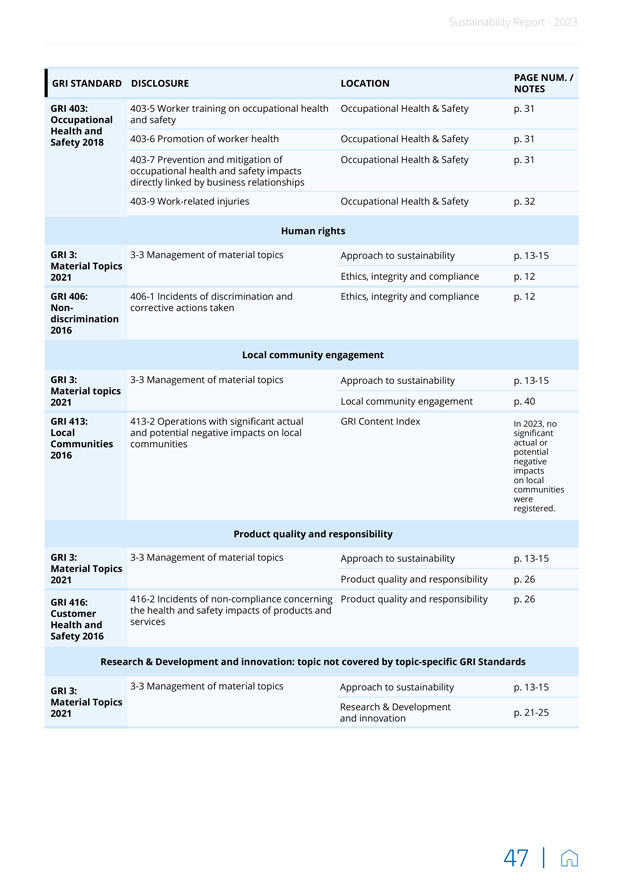
Sustainability Report—2023 PAGE NUM. / GRI STANDARD DISCLOSURE LOCATION NOTES GRI 403: 403-5 Worker training on occupational health Occupational Health & Safety p . 31 Occupational and safety Health and Safety 2018 403-6 Promotion of worker health Occupational Health & Safety p. 31 403-7 Prevention and mitigation of Occupational Health & Safety p. 31 occupational health and safety impacts directly linked by business relationships 403-9 Work-related injuries Occupational Health & Safety p. 32 Human rights GRI 3: 3-3 Management of material topics Approach to sustainability p. 13-15 Material Topics Ethics, integrity and compliance p. 12 2021 GRI 406: 406-1 Incidents of discrimination and Ethics, integrity and compliance p. 12 Non- corrective actions taken discrimination 2016 Local community engagement GRI 3: 3-3 Management of material topics Approach to sustainability p. 13-15 Material topics Local community engagement p. 40 2021 GRI 413: 413-2 Operations with significant actual GRI Content Index In 2023, no Local and potential negative impacts on local significant Communities communities actual or 2016 potential negative impacts on local communities were registered. Product quality and responsibility GRI 3: 3-3 Management of material topics Approach to sustainability p. 13-15 Material Topics Product quality and responsibility p. 26 2021 GRI 416: 416-2 Incidents of non-compliance concerning Product quality and responsibility p. 26 Customer the health and safety impacts of products and Health and services Safety 2016 Research & Development and innovation: topic not covered by topic-specific GRI Standards GRI 3: 3-3 Management of material topics Approach to sustainability p. 13-15 Material Topics Research & Development p. 21-25 2021 and innovation 47 |
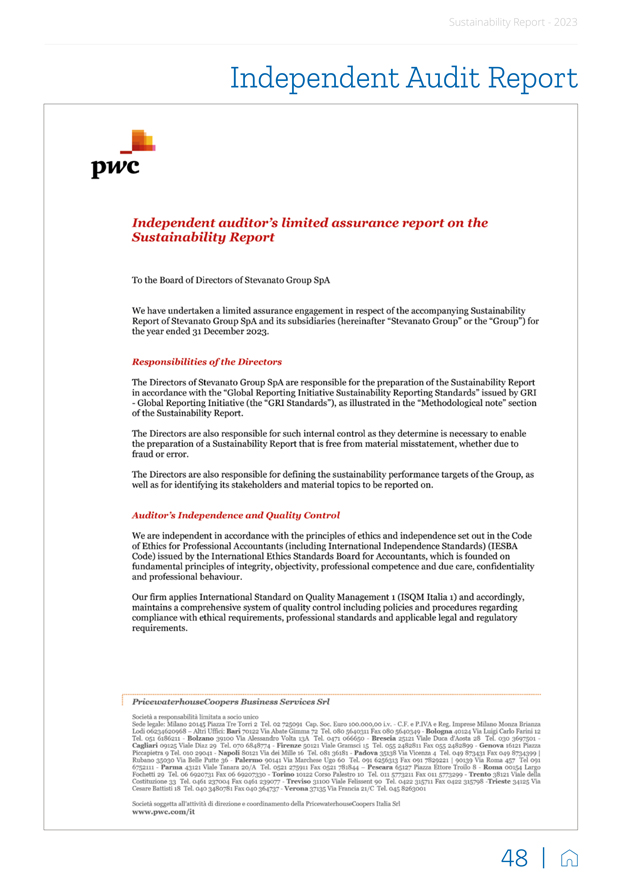
Sustainability Report—2023 Independent Audit Report pwc Independent auditor’s limited assurance report on the Sustainability Report To the Board of Directors of Stevanato Group SpA We have undertaken a limited assurance engagement in respect of the accompanying Sustainability Report of Stevanato Group SpA and its subsidiaries (hereinafter “Stevanato Group” or the “Group”) for the year ended 31 December 2023. Responsibilities of the Directors The Directors of Stevanato Group SpA are responsible for the preparation of the Sustainability Report in accordance with the “Global Reporting Initiative Sustainability Reporting Standards” issued by GRI—Global Reporting Initiative (the “GRI Standards”), as illustrated in the “Methodological note” section of the Sustainability Report. The Directors are also responsible for such internal control as they determine is necessary to enable the preparation of a Sustainability Report that is free from material misstatement, whether due to fraud or error, llie Directors are also responsible for defining the sustainability performance targets of tile Group, as well as for identifying its stakeholders and material topics to be reported on. Auditor’s Independence and Quality Control We are independent in accordance with the principles of ethics and independence set out in the Code of Ethics for Professional Accountants (including International Independence Standards) (IESBA Code) issued by the International Ethics Standards Board for Accountants, which is founded on fundamental principles of integrity, objectivity, professional competence and due care, confidentiality and professional behaviour. Our firm applies International Standard on Quality Management 1 (ISQM Italia 1) and accordingly, maintains a comprehensive system of quality control including polities and procedures regarding compliance with ethical requirements, professional standards and applicable legal and regulatory requirements. PriceivaterhouseCoopers Business Services StI Sorielh a Tesponsabilita limitnta a socio union Scdeletalr; Milnno 20l4r> Piazw Trc Torn 2 Trl, 0272s091 Cop, Soc, Euroloo.ooo.ooC F e P.1VAr Rr£. Imprrae MrlonoMama BrionKi Lodi 06234020968—Attn L’ffid: Bart 70122 Via Abate Cimnui ~2 TeL 0S0 3640311 Fax 080 5640349—Bologna ,10124 Via Line) Carlo Farini 12 Tel, 051 6186:211—Bolzano 39100 Via Alessandro Volta 13A Tel. 0471 06665U—Brescia asm Male Duca d’Aosia 28 Tel, 030 3697501 -fagliari noias Viale Diaz 29 Tel. 070 6848774 Firrn/r 50121 Viala Gramsri is Tel. 055 2482811 Fax 055 2482899—Gmov* 16121 Puma PvrrapiKra <> Tr-I 010 29041 -Napoli 80121 Via dpi Milk” 16 Tel. 081 36161—Padova 3513S Via WertM 4 T*-l 049 873431 Fax 0498734399 I Rubano 35030 Via Belle Putte 30 I’alrrnio 90141 \ j;i Marches? Lro 60 Td. 091 6256313 Fax 091 7H29221 i 90139 Via Roma 457 Tel 091 6752111—Parma 43121 Viale Tanira 20/A Tel. 0S2l 2759U Fax 0521 781844—Pescara 65127 Piaiza FJtore Troilo 8 Roma 00154 iJTfp Fochetti 29 Tel. 06 6920731 Fax 06 69207330—Torino 10122 Corao Palestra 10 TeL on 5773211 Fax 0115773299—Trrnto 38121 Vlata delln Costihizione 33 Tel. 0461 237004 Fax 0461 239077—Trcviso 31100 Vude Feleaent 90 TeL 0422 315711 Fax D422 315798 -Trieste 34125 Via Cesara BanLsti iR Tel. 040 3480781 Fax 04a 364737 Verona37135 VLh Frajicia 21/C TeL 045 8263*1 ni Soriela wggelta all allmli di direzione e courdinaiuenlo delta PricewTrterrmustCoopro Italia Sri www,£twr.<MJrll/it 48 |
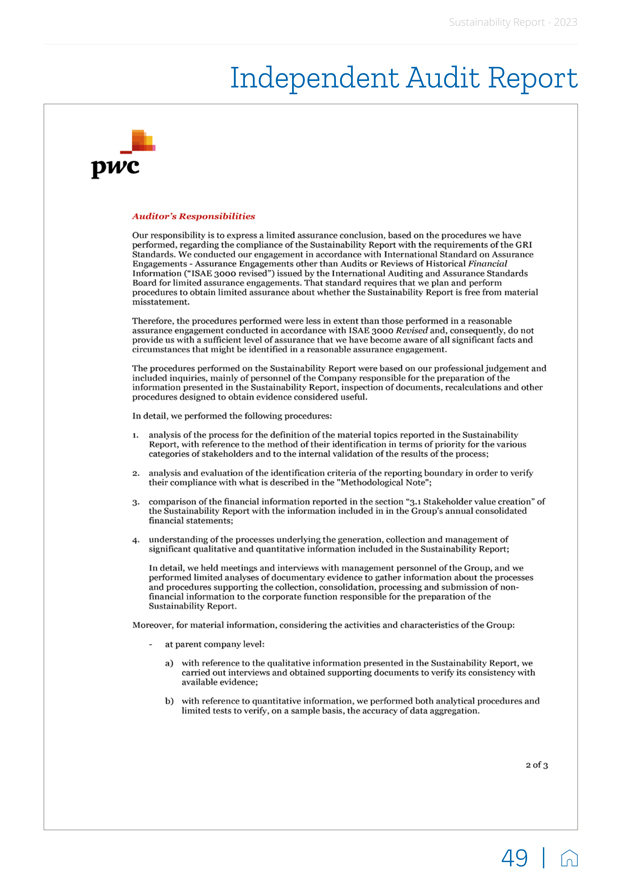
Sustainability Report—2023 Independent Audit Report pwc Auditor’s Kesponsibilit ies Our responsibility is to express a limited assurance conclusion, based on the procedures we have performed, regarding the compliance of the Sustainability Report with the requirement* of theGRI Standards, We conducted our engagement in accordance with International Standard on Assurance Engagements—Assurance Engagements other than Audits or Reviews of Historical Fiiitmcial Information (“ISAIi 3000 revised”) issued by the International Auditing and Assnrance Standards Board for limited assurance engagements, That standard requires that we plan and perform procedures to obtain limited assurance about whether the Suslainabilily Report is free from material misstatement. Therefore, the procedures performed were less in extent than those performed in a reasonable assurance engagement conducted in accordance with [SAE 3000 Revised and, consequently; do not provide us with a sufficient level of assurance that we have become aware of all significant nuts and circumstances thai might he identified in a reasonable jissurauce engagement. The procedures performed on the Sustainability Report were based on our professional judgement and included inquiries, mainly of personnel of the Company responsible for the preparation of the information presented in the Sustainability Report, inspection of documents, recalculations and other procedures designed to obtain evidence considered useful. In detail, we performed the following procedures: 1. analysis of the process for the definition of the material topics reported in the Sustainability Report, with reference to the method of their identification in terms of priority for the various categories of stakeholders and to the internal validation of the results of the process; 2. analysis and evaluation of the identification criteria of the reporting boundary in order to verify their compliance with what is described in the “Methodological Note”; 3. comparison of the financial information reported in the section “3.1 Stakeholder value creation” of the Sustainability Report with the information included in in the Croup’s annual consolidated financial statements; 4. understanding of the processes underlying the generation, collection and management of significant qualitative and quantitative information included in the Sustainability Report; In detail, we held meetings and interviews with management personnel or the Group, and we performed limited analyses of documentary evidence to gather information about the processes and piueedures supporting the collection, consolidation, processing and submission of [ion-ftnancial information to the corporate function responsible for the preparation of the Sustainability Report, Moreover, for material information, considering the activities and characteristics of the Group: at parent company level: a) with reference to the qualitative information presented in the Sustainability Report, we carried out interviews and obtained supporting documents to verify’ its consistency with available evidence; h) with reference to quantitative in formal ion, we performed both analytical procedures and limited tests to verify, on a sample basis, the accuracy of data aggregation, 2 of 3 49 |
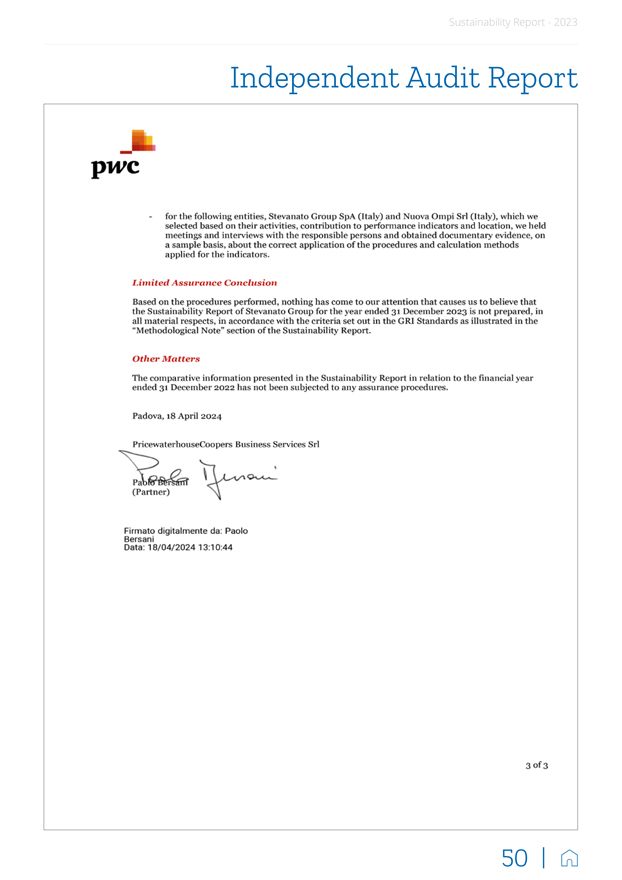
Sustainability Report—2023 Independent Audit Report for the following entities, Stevanato Croup SpA (Italy) and Nuova Ompi Sii (Italy), which we selected based on their activities, contribution to performance indicators and location, we held meetings and interviews with the responsible persons and obtained documentary evidence, on a sample basis, about the correct application of the procedures and calculation methods applied for the indicators. Limited Assurance Conclusion Based on the procedures performed, nothing has come to our attention that causes us to believe that the Sustainability Report of Stevanato Group fur the year ended 31 December 2023 is not prepared, in all material respects, in accordance with the criteria set out in the GRJ Standards as illustrated in the “Methodological Note” section of the Sustainability Report. Other Matter if The comparative information presented in the Sustainability Report in relation to (he financial year ended 31 December 2022 has not been subjected to any assurance procedures. Padova, 18 April 2024 PrieewaterhouseCoopers Business Services Sri (Partner) \\ Fitmato digitaimente da; Paolo Bersani Data: 16/04/202413:10:44 50 |

Headquarters Via Molinella, 17 35017 Piombino Dese Padova, Italy Global footprint with operating units and commercial offices in 9 countries. Visit our website to contact us. stevanatogroup.com